Arlene Stafford-Wilson's Blog, page 42
August 27, 2021
Oakes Bakery
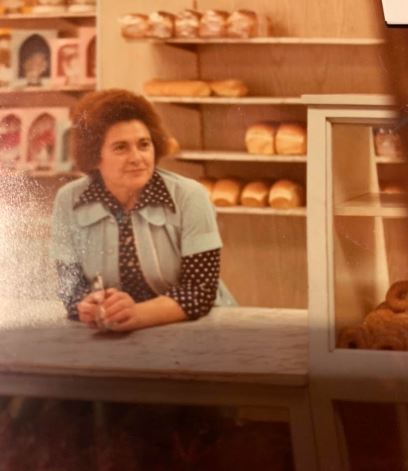
Win Oakes, at Oakes Bakery, 37 Foster Street, Perth, ON, photo: courtesy of Kristine Oakes
Oakes Bakery
Long John or Honey-Dipped Donut? Which was the best?
That was the long-standing debate, at the Perth and District Collegiate Institute, for as long as I can remember. Some liked the soft split donut with the rich whipped cream down the center, and then there were others who couldn’t get enough of its main rival – the doughy, firm-glazed, honey-dipped delights.

The 2 favourites, at the center of the great debate at P.D.C.I. – Which was best?

Whichever of the two you preferred, they could both be found at Perth, Ontario’s much-loved bakery, Oakes Bakery, a respected, popular business, serving the town and surrounding area for over 55 years.
Oakes Bakery:
A Little Bit of History
Thomas Edward Oakes 1867-1933
In 1893, Thomas Oakes, a stone-cutter by trade, made the decision to move to Perth from Almonte. He heard through the grapevine that a thriving stone-crafting industry was booming in the busy town, and soon after, he secured a position with the Campbell Monument Works, crafting, polishing and engraving marble and granite tombstones.
While Thomas’ days were busy working as a stone-cutter, he was also widely known as a sociable fellow. He began to date a charming beauty, born in Bathurst Township, and like Thomas, a member of St. James Anglican Church, in Perth. On a chilly January afternoon, in 1896, after many months of courtship, Thomas, age 28, married Mary Elizabeth Morris, age 21, daughter of William Morris and Catherine Sly. Thomas and Mary had a large family of six children: Florence, William, Dorothy, Delbert, Elsie, and Laura.
William Oakes –
Founder of the Bakery
1898-1963
Bill Oakes, Thomas’ eldest son, at age 20, married Stella Fleming in 1919:
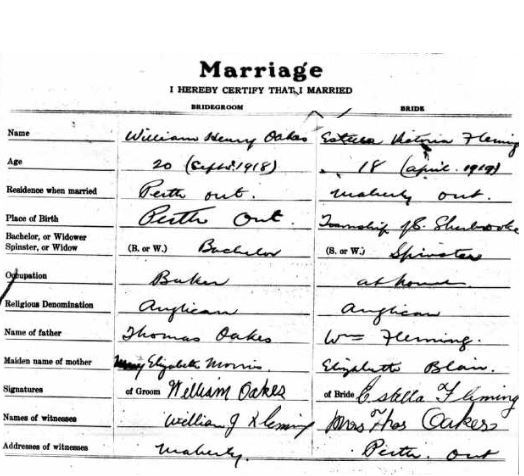 Marriage of Bill Oakes to Stella Fleming – from: Ontario, Canada, Marriages, 1826-1938
Marriage of Bill Oakes to Stella Fleming – from: Ontario, Canada, Marriages, 1826-1938Apprenticeship at Woodcock Bakery
Bill and Stella moved to Carleton Place, where he was employed with Woodcock Bakery, at 152 Bridge Street. The Woodcock family were pleased to have such an eager and hard-working trainee, and Bill, in turn, was learning everything he could about operating a bakery.
Oakes Bakery
Opens for Business 1926

On May 1, 1926 – Bill and Stella Oakes opened their bakery at 60 Foster Street. Bill ran the bakery, and his brother, Delbert ‘Deb’ delivered the goods by horse and buggy. In 1948 the business moved to 37 Foster Street.
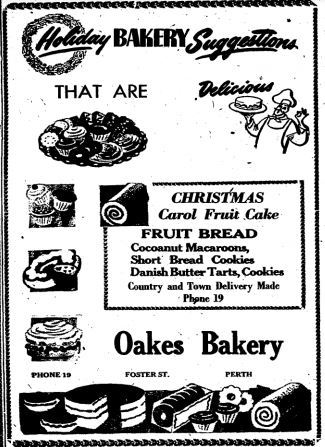
Dec. 15, 1949, p.3, “The Perth Courier”
In the 1950s, Oakes Bakery began to offer deli selections,
as well as their popular baked goods.
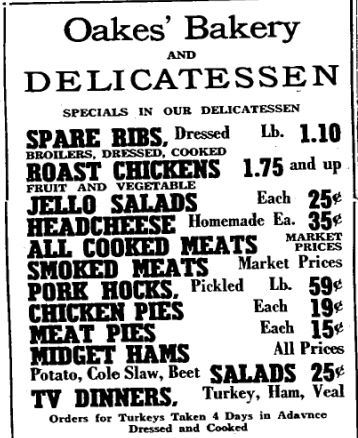
“The Perth Courier”, July 12, 1956, p 10
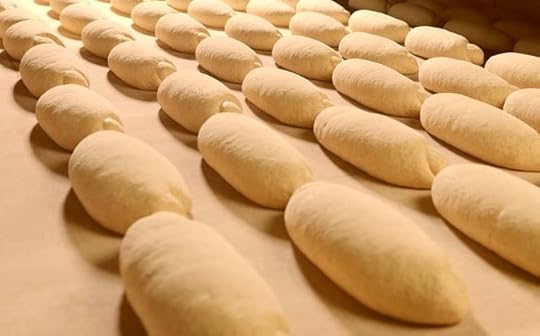
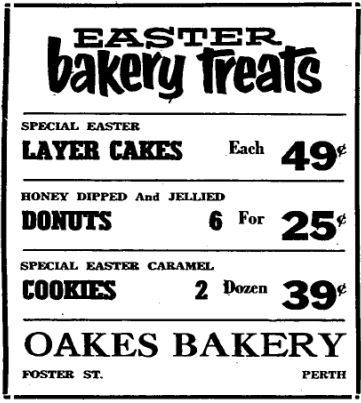
“The Perth Courier”, March 26, 1959, p.9
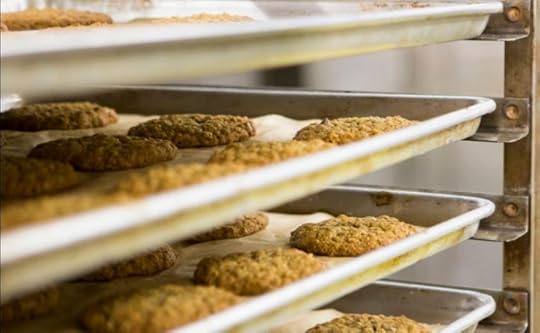
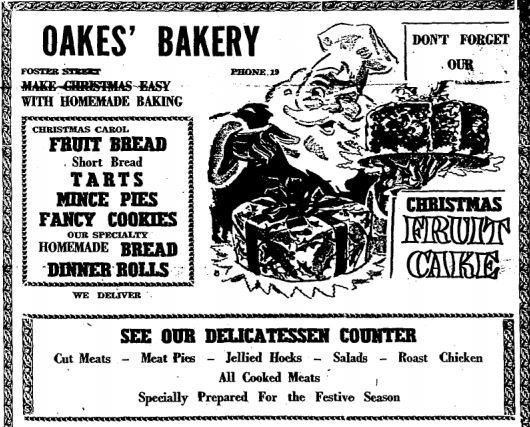
“The Perth Courier”, Dec. 17, 1959, p. 13
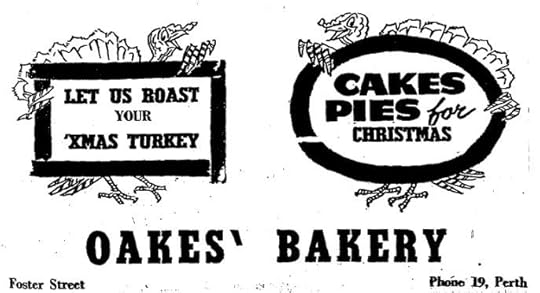
Dec. 17, 1959, p 13 “The Perth Courier”
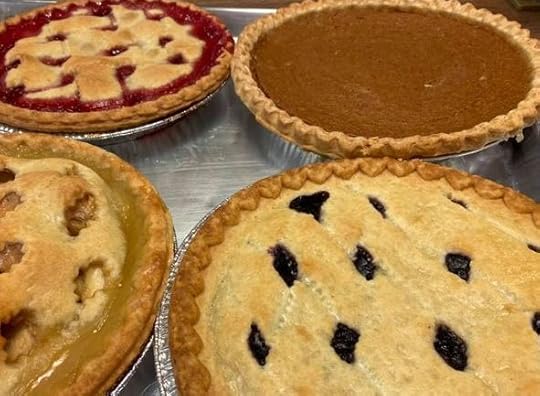
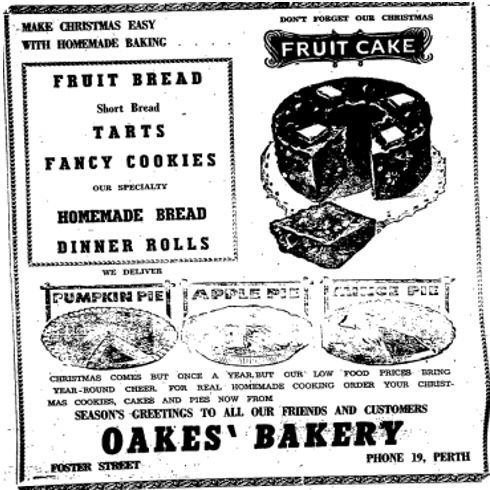
Dec. 21, 1961, p. 12, “The Perth Courier”

The Bakers:
Donald ‘Donny’ Oakes, Roy Van Iderstine, Richard ‘Rick’ Oakes, Steven Cordick, Paul Carter, Harold Matheson, Terry Truelove, Michael Jordan, Kevin Beamish, Iqbal Umar, Gerry Huddleston.
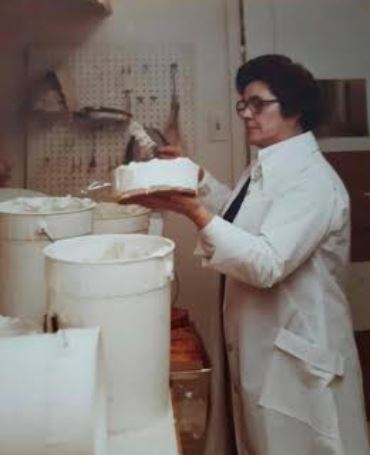
Win Oakes, icing a cake, at Oakes Bakery, 37 Foster Street, Perth, ON, photo courtesy of Kristine Oakes
Bakery Founder Bill Oakes,
passes away – 1963
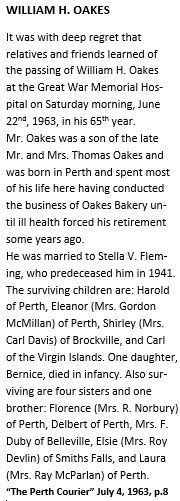
(missing from the obituary are son, Donald, son William ‘Bill’, and daughter, June – thanks to Janie Kerr for pointing out the omission)
Along with sponsoring many local events over the years, like the Festival of the Maples, the Mutt Show at the Perth Fair, and countless other charities, Oakes Bakery also sponsored a talk show on CJET Radio, with host, Don Crawford, called “Legion Line”
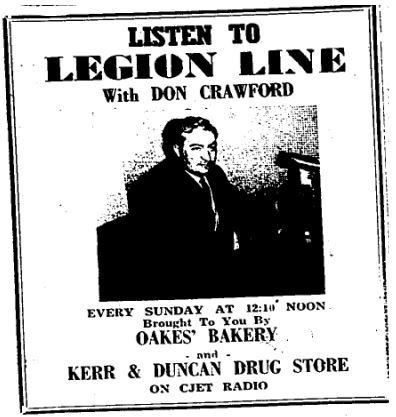
March 18, 1965, p. 10, “The Perth Courier”

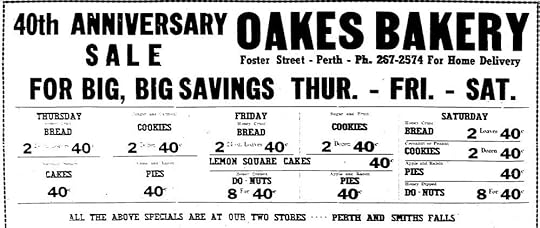
Oakes 40th Anniversary – Apr. 21, 1966, p. 8, “The Perth Courier”
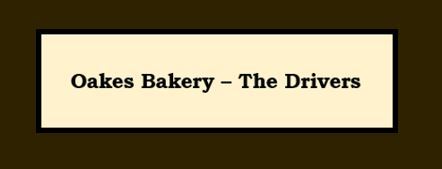
The first driver for Oakes Bakery was Delbert ‘Deb’ Oakes, brother of the owner, William Oakes. Deb delivered baked goods throughout the town of Perth, on a horse and cart, beginning in 1926. In the years that followed, modern trucks were added to the fleet, and deliveries expanded beyond the town of Perth.
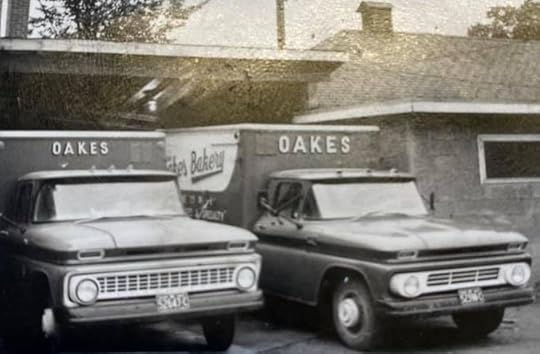
Oakes Bakery – trucks, photo courtesy of Tom Oakes
Don McAdam, Eldred Beamish,
Ernie Moore, and Walter Bentley
In the 1960s, Eldred Beamish, delivered to customers in Ompah and along Snow Road, Ernie Moore, delivered to Burritt’s Rapids, and Walter Bentley, whose route included most of the Drummond Centre area. Don McAdam delivered in Perth, as well as the Christie Lake route.
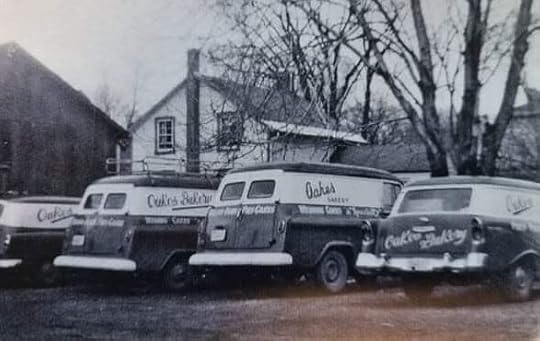
Oakes Bakery trucks – 1960, photo: courtesy of Shirley Oakes
1970s and 1980s – Drivers
Edred Beamish, Robert Roussel,
Michael Lefebvre
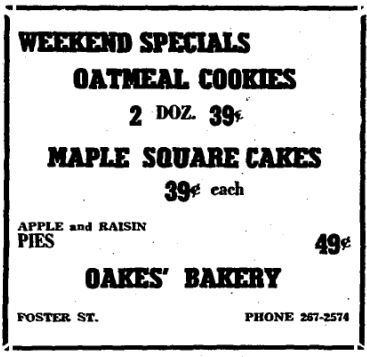
June 23, 1966, p. 3, “The Perth Courier”

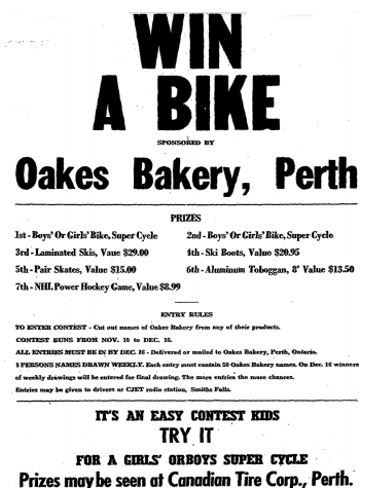
Nov. 24, 1966, p. 9 “The Perth Courier”
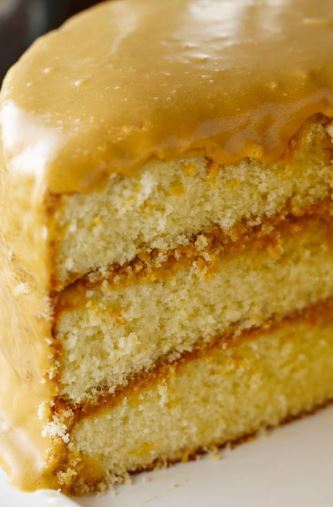
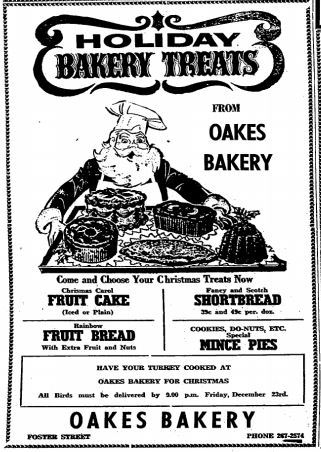
Dec. 15, 1966, p. 4, “The Perth Courier”

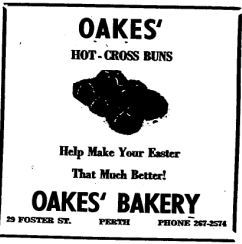
Apr. 3, 1969, p. 7 “The Perth Courier”

Traditional Hot Cross buns, served in the weeks leading up to Easter, were a popular treat at Oakes Bakery.
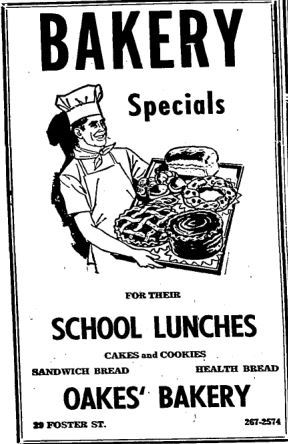
Aug. 28, 1969, p. 10, “The Perth Courier”
Oakes Bakery –
Christening and Baptism Cakes
Oakes Bakery generously donated a beautiful Christening Cake each New Year to the parents of the first baby born at the Perth Hospital. Traditional christening and baptism cakes were always white, some were round, tiered, and resembled a wedding cakes. Rectangular sheet-style cakes were also popular, and were usually white, some decorated with a cross. More modern cakes were decorated using pastel colours, like pink or blue, but the majority of cakes produced were all white.
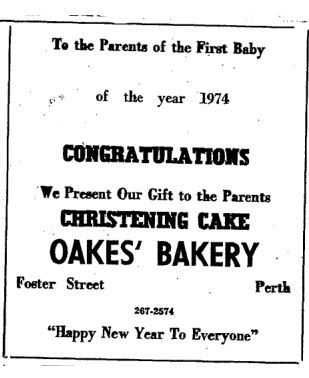
Dec. 27, 1973 p. 10, “The Perth Courier”

(Above: Christening and Baptism cakes – white sheet cakes, iced in white were popular)


Oakes Storefront Staff
– Assisted customers, took orders for wedding cakes, and specialty cakes, boxed and packaged orders, handles payments and in-store sales:
Winnifred ‘Win’ Oakes, Shirley Oakes, Betty Oakes, Diane Bowes, Vena Shanks, Wanda Shanks, Wendy Kehoe, Christine Schauber, Connie Burns, Lisa Anderson, Shannon Matheson, Doug Young, Doug McDonald
At the Smiths Falls store:
Working at their Main Street store in Smiths Falls: Mary Horricks, Webb and Helen Young, and at the County Fair Mall location: Joan Beamish, Kathy Beamish, Charmaine Gill, Kelly O’Neill, Marie Stoddard, and Wendy Thomas. Office staff at that time: Norma Adams and Linda Dowdall.
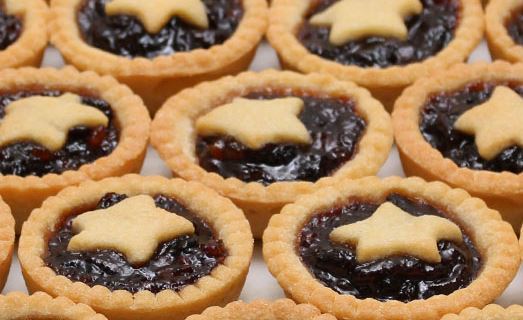
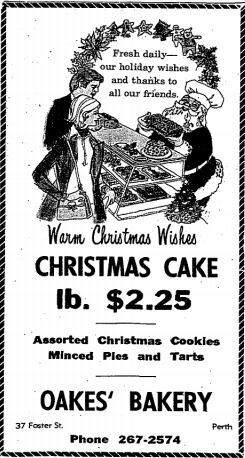
Dec. 12, 1974, p. 4 “The Perth Courier”

In 1976, Oakes Bakery celebrated it’s 50th year in business.

Oct. 21, 1976. p 10 “The Perth Courier”
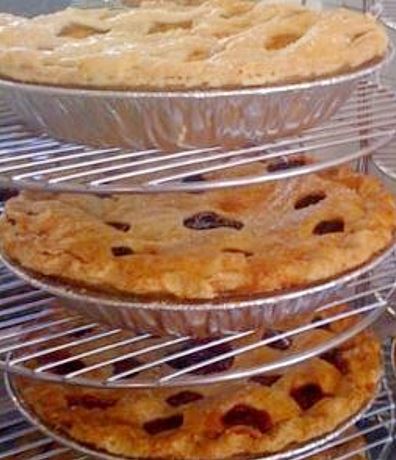
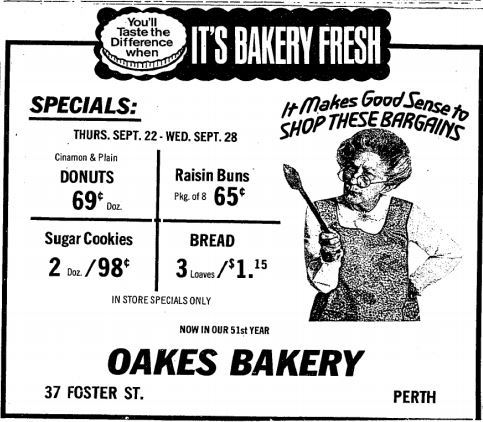
Sept. 22, 1977, p. 13 “The Perth Courier”
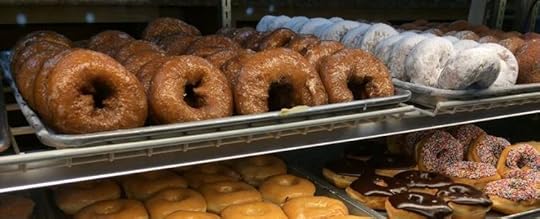

Mar. 1, 1978, p. 8, “The Perth Courier”
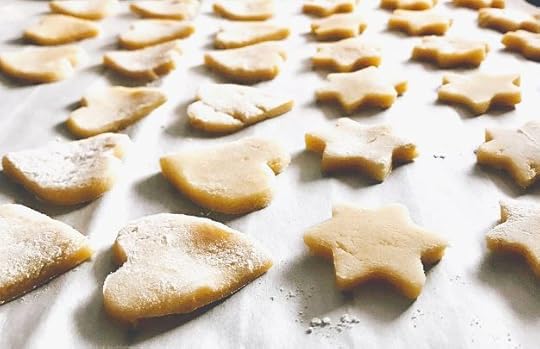
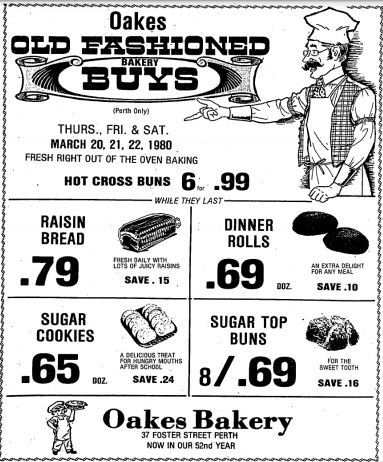
Mar. 19, 1980, p. 15 “The Perth Courier”
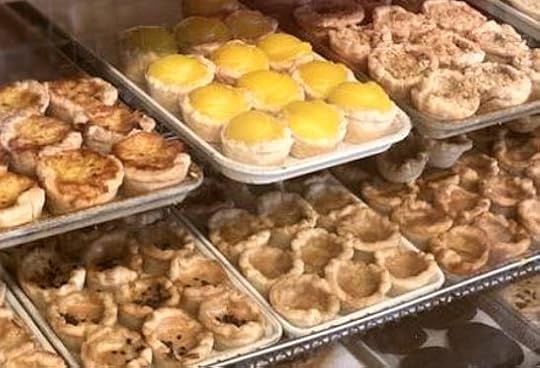
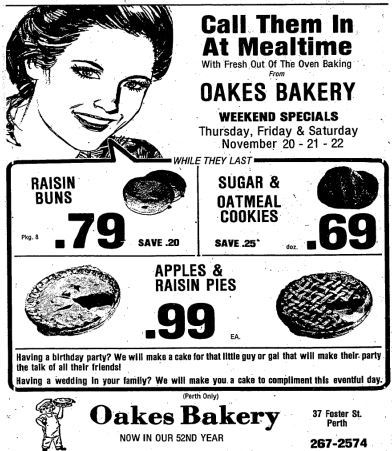
Nov. 19, 1980, p. 26, “The Perth Courier”


Feb. 4, 1981, p. 26, “The Perth Courier”

Wedding Cakes
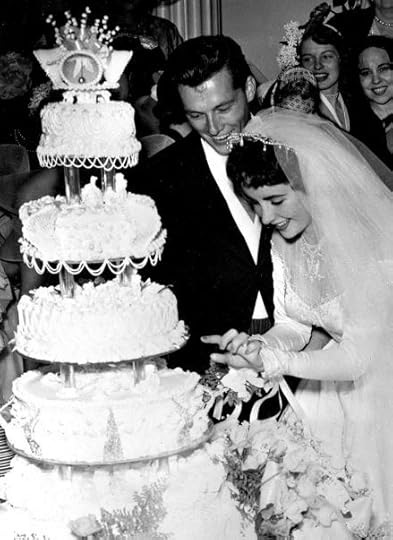
Oakes Bakery was well-known for their beautiful wedding cakes, and traditional toppers. Most of their wedding cakes were fruit cakes decorated in white icing, and created in several layers of increasing sizes. It was popular to bake a separate fruit cake, iced in white, cut in small pieces and wrapped and given to wedding guests at the table, beside their place setting. Wedding bells were popular cake toppers, or small figures depicting the bride and groom.

Above: 1940s Cake Topper
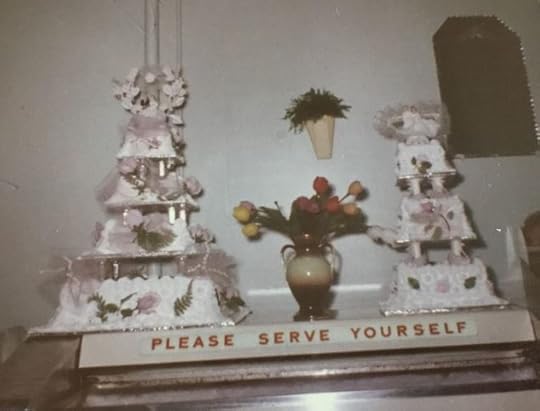
Wedding cakes on display at Oakes Bakery in the 1960s – photo courtesy of Shirley Oakes
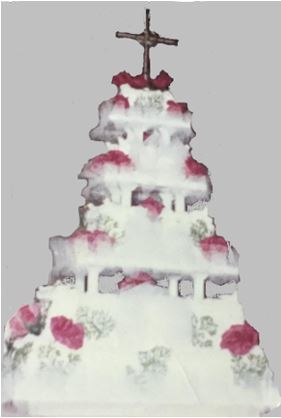
Shirley Oakes’ wedding cake, traditional fruit cake, iced by Shirley and Win Oakes, in 1963, photo: courtesy of Shirley Oakes
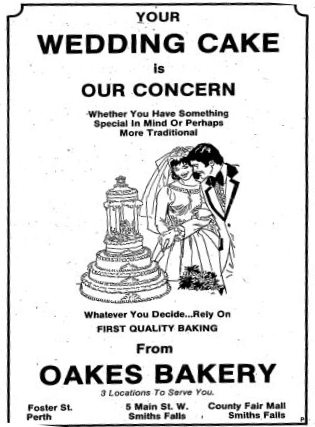
Mar. 11, 1981, p. 51, “The Perth Courier”

A classic style wedding cake with topper, like many that were made by the talented staff at Oakes Bakery
Traditional fruit cake, cut in small pieces, with white marzipan icing, and wrapped in plastic wrap, were popular wedding favours for guests,at each place setting at a wedding supper.


Slices of wedding cake were often wrapped in plastic, then wrapped in a doily, with a ribbon tied around the middle, and given as a ‘favour’ to wedding guests.
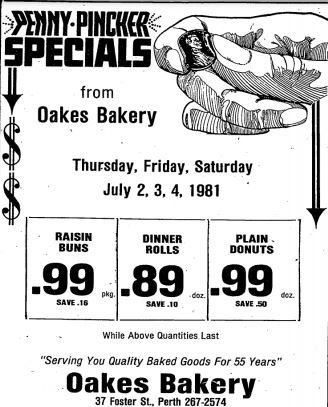
July 1, 1981, p. 34, “The Perth Courier”
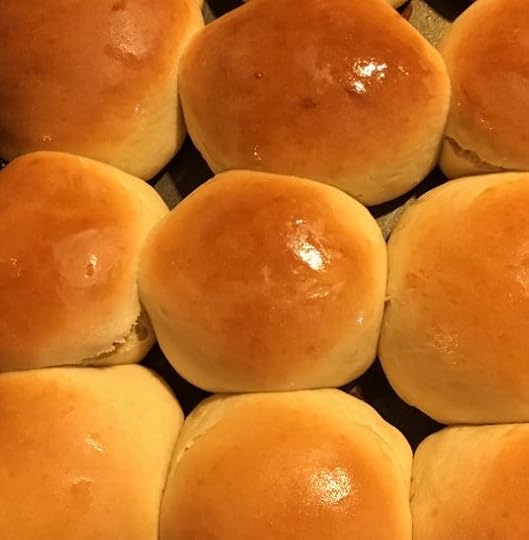

In 1981, Oakes Bakery celebrated their 55th year in business.
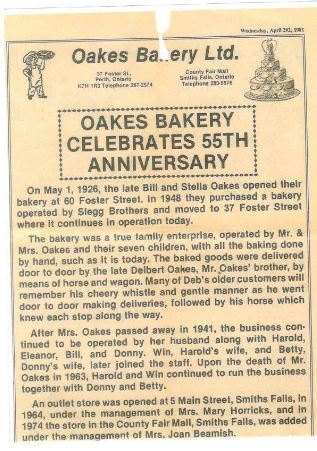
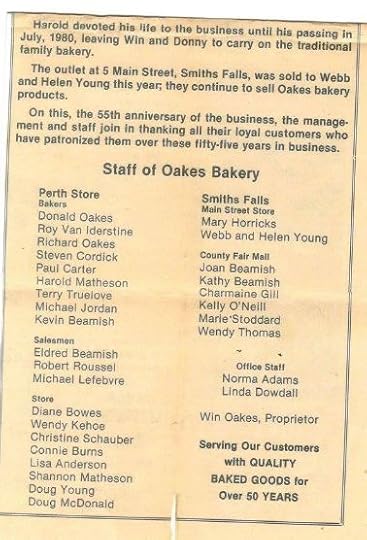
Oakes 55th Anniversary announcement – courtesy of Kristine Oakes

Dec. 23, 1981, p. 43, “The Perth Courier”
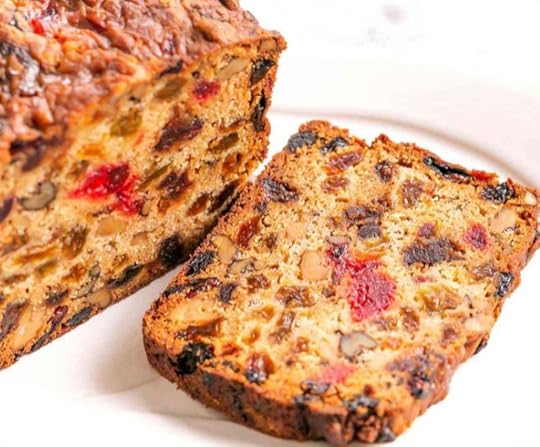

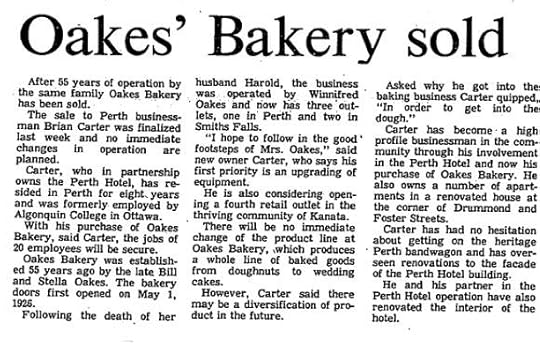
Jan. 13, 1982, p. 1 “The Perth Courier”
Read the Story of Oakes Bakery
New Book – Sat. Sept. 11th, 1 – 3 p.m.
The Book Nook, Perth, ON
Coming this fall, the story of Oakes Bakery, one of a collection of short stories in “Lanark County Comfort: Homespun Tales to Warm Your Heart”.
Discover the tragedies and the triumphs of this well-loved Perth business. What was it like to work there? Stories and anecdotes from members of the Oakes family and from former staff-members. Re-live the glory days, follow the drivers on their delivery routes, and visit behind the scenes with the talented bakers. Read about that fateful night in 1947 when a local police officer discovered a fire at the bakery that could have ended it all……
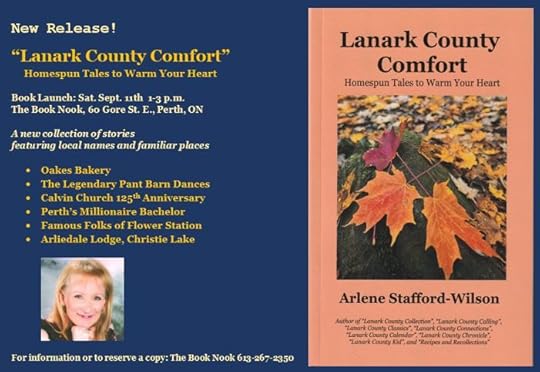
For information, or to reserve your copy:
NEW RELEASE (preorder) – Lanark County Comfort; Home spun tails to warm your heart – Arlene Stafford-Wilson
August 26, 2021
2021 Release – “Lanark County Comfort”
Book Launch: Saturday, September 11th, 1 – 3 p.m.
at The Book Nook, 60 Gore St. E., Perth, Ontario, Canada
For information: 613-267-2350


Table of Contents:
Chapter 1 – Oakes Bakery: Tasty Treats in the Town of Perth
Chapter 2 – Pant Barn Dances: Blue Jeans & Rock and Roll
Chapter 3 – Famous Folks of Flower Station
Chapter 4 – Perth’s Millionaire Bachelor
Chapter 5 – Calvin United Church 125th Anniversary
Chapter 6 – Arliedale Lodge, Christie Lake
In this collection of short stories the author invites you to visit some extraordinary places and meet some fascinating people who left their mark in Lanark County. Come to cottage country and visit Arliedale Lodge on Christie Lake, playground of the rich and famous, where the legendary Marks Brothers hosted unforgettable parties. Meet the Oakes family, and discover the tragedies and triumphs of their much-loved bakery in Perth. Spend an unforgettable evening at a Pant Barn Dance, meet the rock and roll bands, and find out what went on behind the scenes at these legendary concerts. Celebrate with the members of a 125-year-old country church at an old-fashioned strawberry social and learn the secrets of the popularity and longevity of this special place. Take a Sunday drive into the Lanark Highlands, meet the fascinating folks of Flower Station who may have uncovered the secrets of the fountain of youth. Meet Perth’s millionaire bachelor, discover a legal scandal that rocked the town of Perth, and find out who inherited his fortune.
About the Author:
Arlene Stafford-Wilson grew up on a small farm in Lanark County. Former Newsletter Editor and long-time member of the Lanark County Genealogical Society, Member of the Association of Professional Genealogists, and mother of one son, Alexander, she and her husband, Kevin, live in Ottawa, a few blocks from Parliament Hill.
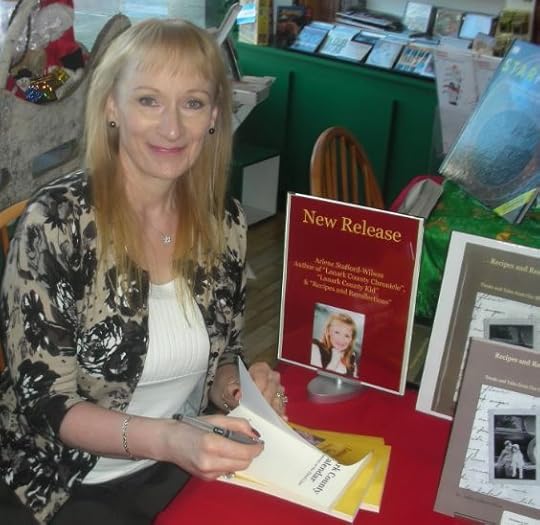
 New Book is # 9 in the series of Lanark County Books
New Book is # 9 in the series of Lanark County BooksA summary of each book can be found on the link below:
New Book Release


“Lanark County Comfort” Previews:
Chapter 1
Oakes Bakery:
Tasty Treats in the Town of Perth
 Win Oakes – photo courtesy of Kristine Oakes
Win Oakes – photo courtesy of Kristine Oakes
 photo: courtesy of Shirley Oakes
photo: courtesy of Shirley OakesDiscover the tragedies and the triumphs of this well-loved Perth business. What was it like to work there? Stories and anecdotes from members of the Oakes family and from former staff-members. Re-live the glory days, follow the drivers on their delivery routes, and visit behind the scenes with the talented bakers. Read about that fateful night in 1947 when a local police officer discovered a fire at the bakery that could have ended it all……
Chapter 2
Pant Barn Dances
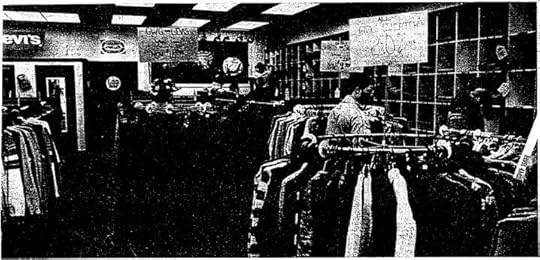 The Pant Barn 51 Foster Street, Perth, ON
The Pant Barn 51 Foster Street, Perth, ON
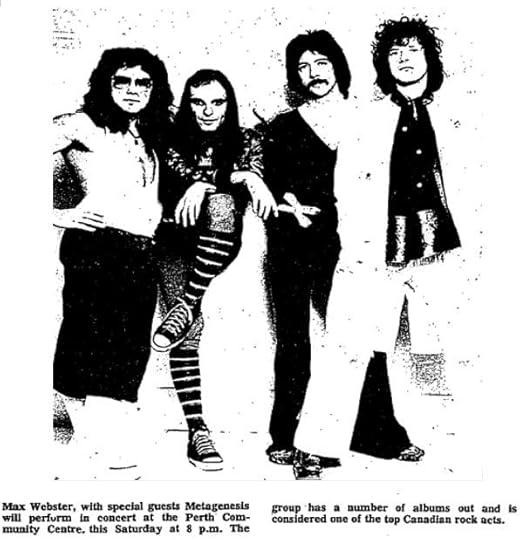
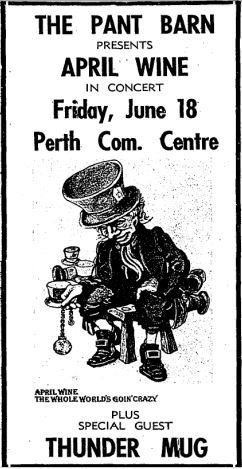
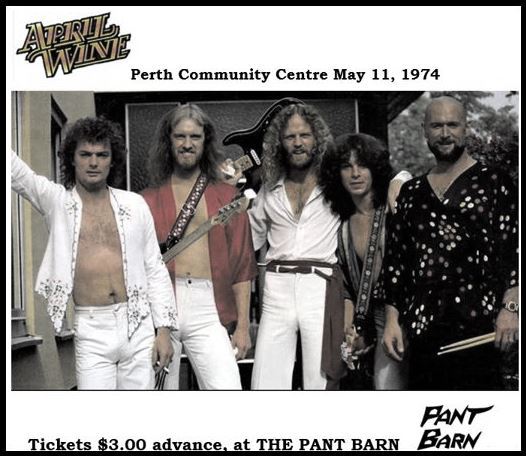
Discover the unforgettable concerts, the rock and roll, and go behind-the-scenes with the bands, all the special memories – With stories and anecdotes from Perry Weagle, and former staff of The Pant Barn and the Perth Community Center. The story that captures the memories – “The Legendary Pant Barn Dances”, part of a collection of short stories in new book, “Lanark County Comfort: Homespun Tales to Warm Your Heart”
Chapter 3
Famous Folks
of Flower Station
Discover the fascinating people, their unique qualities, and their achievements, in the story: “Famous Folks of Flower Station”. Meet the people who may have uncovered the secrets of the fountain of youth – like Jennie ‘Granny’ Majaury – who walked every day, smoked a pipe and lived to be 104. Another famous resident Irene Crosbie who gave birth to 18 children, worked in her family’s store, and lived to be 95. You’ll read about Joe Lalonde, known as the ‘husky young woodcutter from Flower Station’. Nothing could stop Joe from joining the army and serving his country. Winnie Closs, another famous resident, was a newspaper columnist for over 50 years, wrote her columns in long-hand, and lived to be 91.
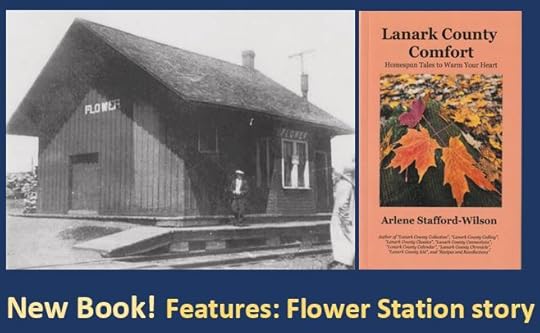
Chapter 4
Perth’s Millionaire Bachelor:
Who Inherited His Fortune?
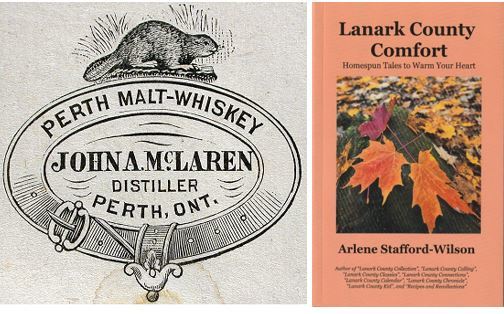
The story of John McLaren, Perth, Ontario’s whiskey baron, and eligible bachelor millionaire, is one of the town’s most intriguing tales. Inventor of the ‘Mickey’, McLaren amassed a fortune during his lifetime, and when he died, unmarried and childless, there was a great deal of interest in who would inherit his money.
Read about the McLaren fortune, the scandalous court case that rocked the town of Perth, and the people who tried to claim a share of his millions. The story, “Perth’s Millionaire Bachelor” is one of a collection of short stories in the new book, “Lanark County Comfort”
Chapter 5
Calvin United Church:
125th Anniversary
2021 marks a milestone in the long rich history of this very special place. To commemorate this 125th anniversary, the history of Calvin United Church is part of a collection of short stories in the book, “Lanark County Comfort: Homespun Tales to Warm Your Heart”.
The story begins from the earliest days before the present church was constructed, and takes the reader through the unsettled times of the first and second world wars, the changing ways of the 1950s -1980s, and into the present days with the challenges of the world pandemic.
Recollections from former and current members, thoughts and insights from current minister, Rev. Micheline Montreuil, as well as stories and memories of many of the members throughout the history of the church.
Discover the social clubs and ladies’ auxiliaries, learn about the lively debating clubs, the romantic box socials, the infamous car races, the strawberry socials, and some of the church’s most distinguished members.
 Calvin United Church, Tay Valley Township, Lanark County, Ontario, Canada
Calvin United Church, Tay Valley Township, Lanark County, Ontario, Canada
Chapter 6
Arliedale Lodge
Christie Lake
Playground of the Rich and Famous
 Arliedale Lodge, Christie Lake
Arliedale Lodge, Christie LakeDiscover the history and the mysteries of this legendary resort, built on a peaceful lake in Eastern Ontario. From the heydays of the famous Marks family and their distinguished guests, hosting the who’s-who of the entertainment industry, and the many owners throughout the years. Read the shocking rumours, learn about a mysterious fire, and what became of this fashionable resort at Christie Lake.

NEW RELEASE (preorder) – Lanark County Comfort; Home spun tails to warm your heart – Arlene Stafford-Wilson
Will also be available at The Bookworm, Perth, ON 613-264-7257
or at:


 The Stafford House – the author’s childhood home, and inspiration for many stories
The Stafford House – the author’s childhood home, and inspiration for many stories“Come join me in a kinder, gentler place, set against a backdrop of peaceful green meadows, under tall sprawling maple trees, and enjoy some good old fashioned Lanark County comfort.”
August 9, 2021
Family Reunions – Lanark County 1970s & 1980s
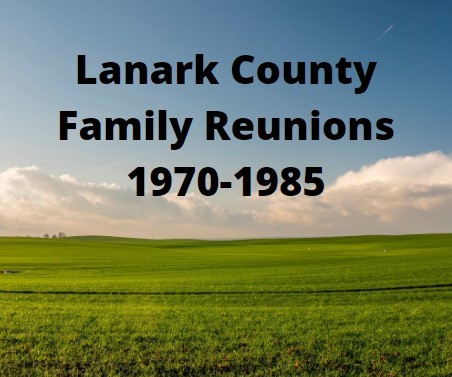
Someone once said,
“Families are like branches on a tree – we all grow in different directions, yet our roots remain as one.”Many families who settled in Lanark County came from Europe – mainly Ireland, Scotland, some from England, and from countless other locations around the world. As sons and daughters grew up and left the family homesteads, they in turn spread out across the country and beyond. Organizing a family reunion became a yearly ritual for some families, and many advertised their reunions in the local papers.
The following is a snapshot of some of the families who held reunions in the 1970s and 1980s in Lanark County. Our story begins with some commentary from a popular local journalist, Bill Smiley, and his personal views on family reunions…..
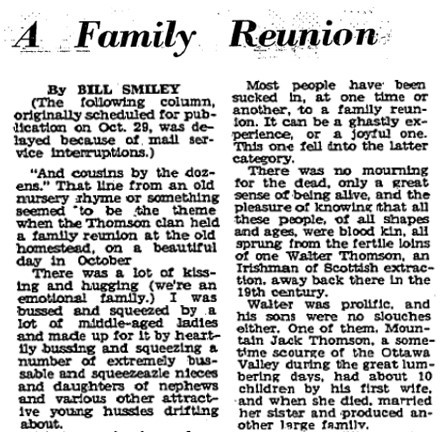

Andison Family(Aug. 6, 1970, p.12 – “The Perth Courier”)
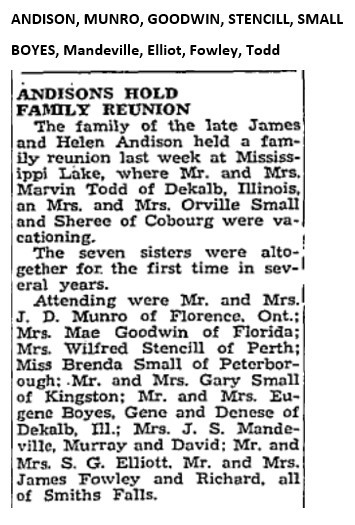
Crampton Family(October 21, 1971, p.10)
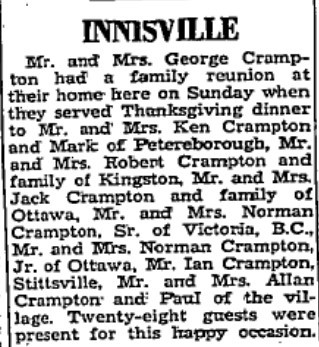
Schonauer Family(July 10, 1975. p. 12)
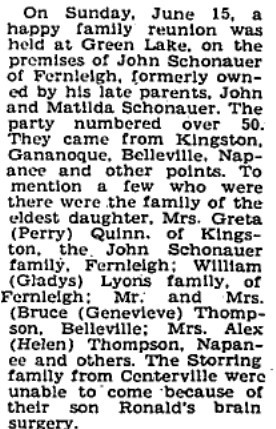
Slack Family(Aug. 28, 1975, p.10)
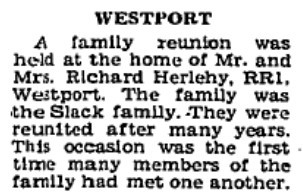
McKay Family
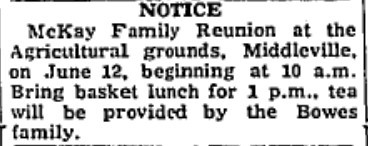
Barr Family
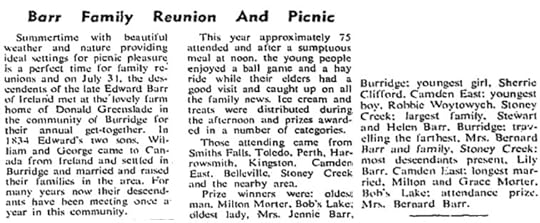
Patterson Family
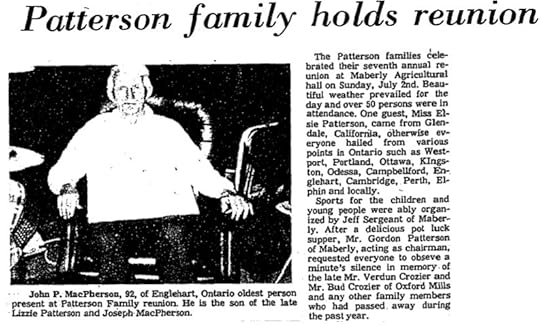
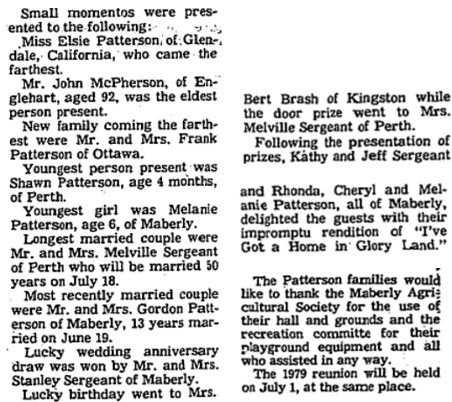
Kirkham Family
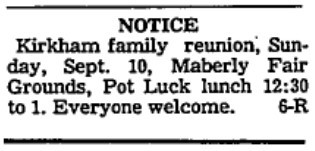
Love Family
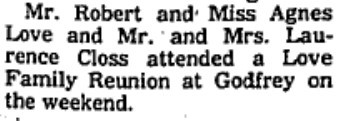
Geddes Family
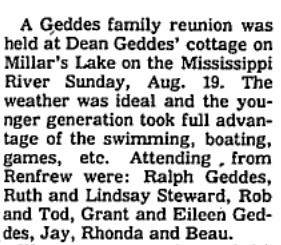
Kirkham, Dixon, McKenacher, Truelove, and Tysick families
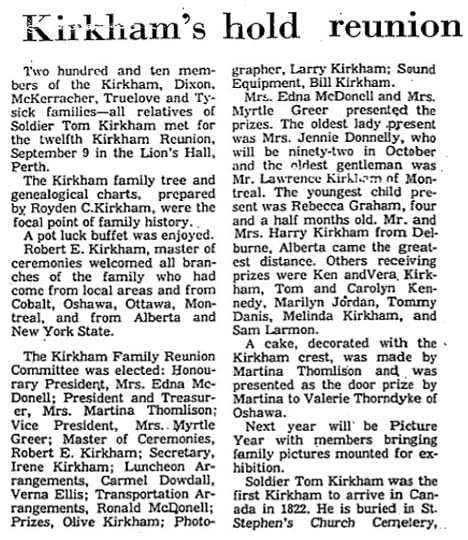

Desjardine Family

Barrie Family

Rintoul Family
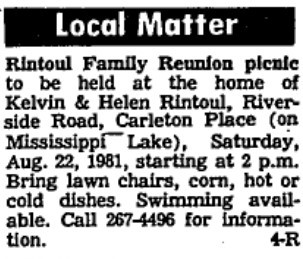
Hermer Family
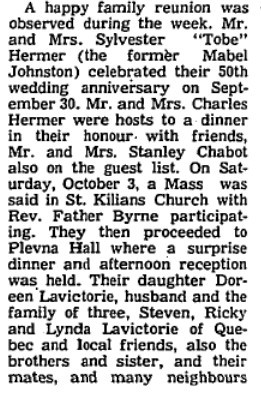
Massey – Marshall Family

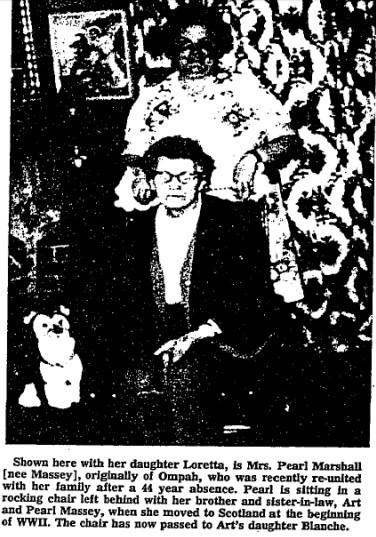
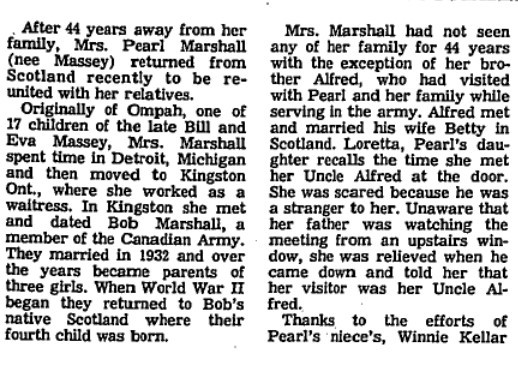
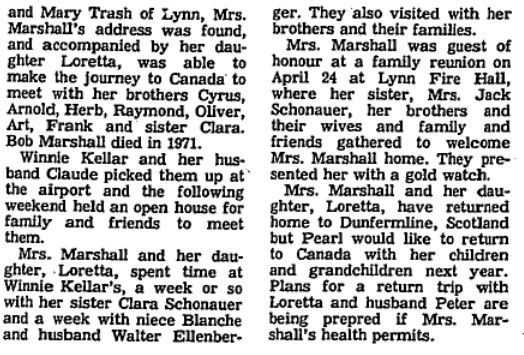
Caswell Family
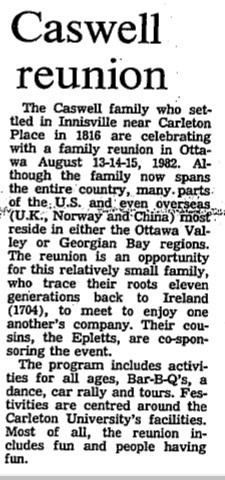
Miller Family
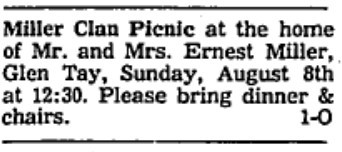
Camelon Family
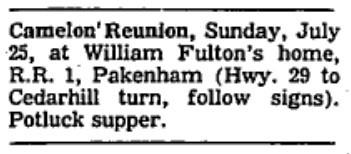
VanAlstine Family

Closs Family
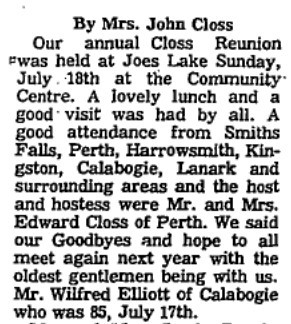
Echlin Family
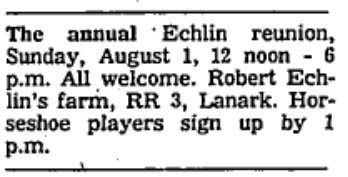
Arnott Family

Larmon Family

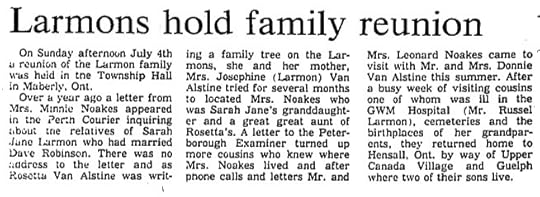
Adrain Family
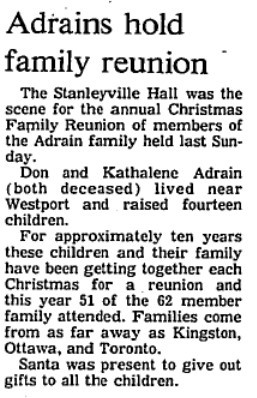
McDonnell Family
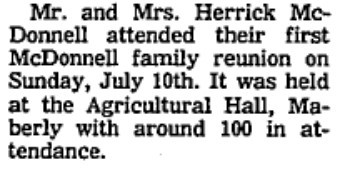
Brady Family
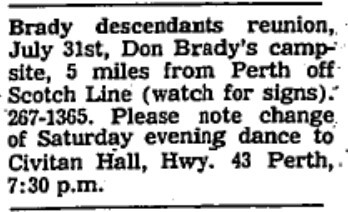
Crosbie and Gemmill Families
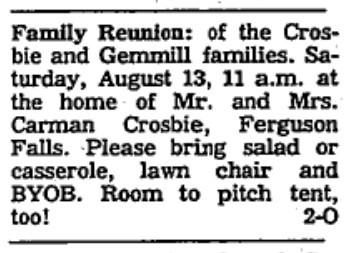
Devlin Family
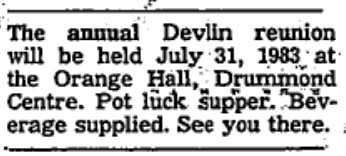
Killingbeck, Koffman, & Baxter Families
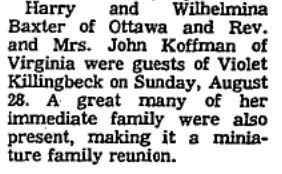
Bowes and Mahon Families

Umpherson Family

McKenzie – Peters, Thomas, Morrow, Kerr

Hill – Millar Families
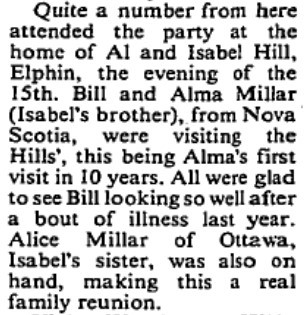
Chabot Family


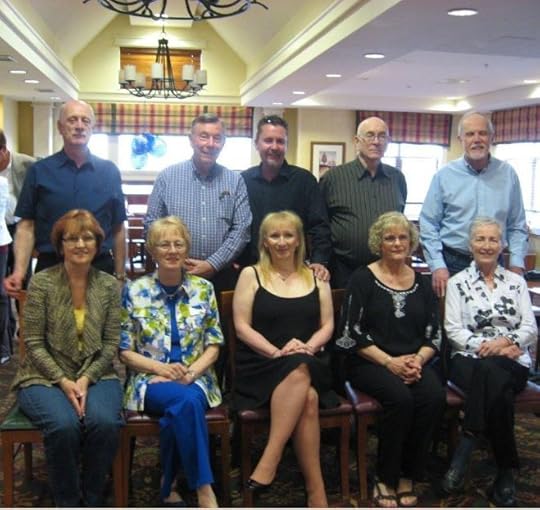
…………………………..
News clippings of all Lanark County family reunions – from: “The Perth Courier”
July 12, 2021
My Mother, she was Orange…..and my Father, he was Green
“You picked a hell of a day to get married!”
Those were the first words spoken to our mother, the day she met her new father-in-law, Vince Stafford. He was referring to the fact that they were married on the twelfth of July. He made it quite clear that he was not pleased that his son had chosen to welcome a Protestant into their Roman Catholic family, on July 12th of all days!
Some called it Orangeman’s Day, and some referred to it as the ‘Glorious Twelfth’. On July 12th each year, Protestant organizations celebrated the victory of Protestant King William of Orange, riding a white horse, who defeated Catholic King James, at the Battle of the Boyne in July 1690.

The Orange and the Green
When I was a kid, the Irish Rovers recorded a song called “The Orange and the Green”, about a child growing up with one Roman Catholic parent, and one Protestant parent. We saw them perform the song many times over on a popular television show called ‘The Pig and Whistle’, and the irony of the song was not lost on us.
Irish Rovers “The Orange and Green”
Our father, a Roman Catholic, from Drummond Township, grew up attending St. Patrick’s church in Ferguson Falls, while our mother attended Calvin United in Bathurst (Tay Valley) Township.

Although the feelings of bias and animosity between these two religions may seem foreign to us in these more inclusive times, they were still very much in the forefront, during the 1940s, when my parents married. Mother said she never felt accepted by Dad’s family, particularly his parents; and that never changed even up to the late 1950s and early 1960s when the in-laws passed away.
This religious prejudice ran on both sides of the fence. I recall our cousin, Ruth Rutherford, in Ogdensburg, New York, was forbidden to marry her sweetheart, a Catholic lad, and she never got over it. She remained single for the rest of her life, unable to marry her true love.
It may be difficult for us to imagine, but there were times in our early history in Canada where it was not uncommon for the July 12th celebrations to result in violence or even death.
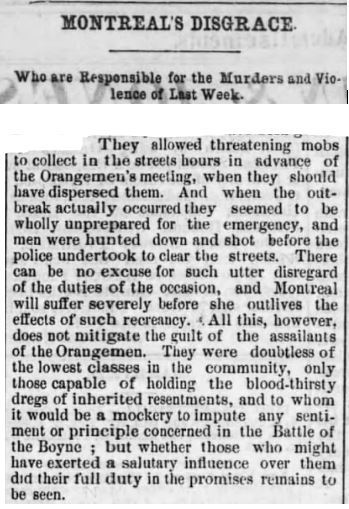
In the early years of the last century, the Orangemen’s Day parades in Canada drew crowds in the thousands, and it was not unusual for fights to break out, and insults along with injuries were to be expected.

Although Orangeism originated in Ireland and England, Ogle Robert Gowan, the Order’s first Canadian Grand Master is recognized as the founder of Canadian Orangeism. It is interesting that Gowan is known to have been a frequent visitor to a local fortune teller, Mother Barnes, the Witch of Plum Hollow. Not wishing to be seen consulting a sooth-sayer, he often sent his wife and their maid to ask questions about his politics and his career.
Orange Lodges, as the membership halls were called, sprang up all over Canada, and in Eastern Ontario, they were a common sight in almost every community. The closest Orange Hall to our house was at Wemyss, frequently used as a dance hall, and a place to play cards and socialize.

Carleton Place was one of the first communities to establish a Loyal Orange Lodge, along with Perth, Smiths Falls, and Montague Township.
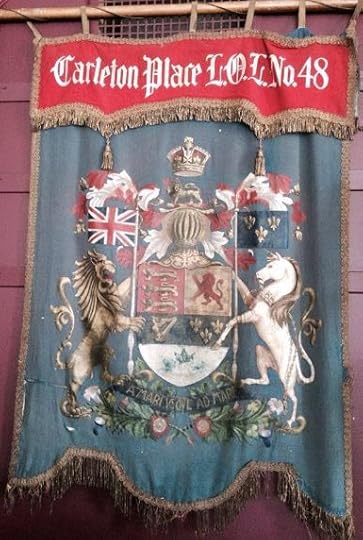
In the early days, thousands attended Orange events:
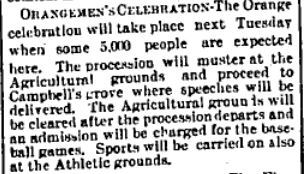
Through the decades, many community organizations also held their meetings and socials at the local Orange halls.
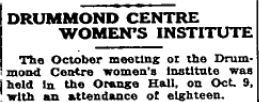
Carleton Place had one of its largest crowds of visitors on July 12, 1920:


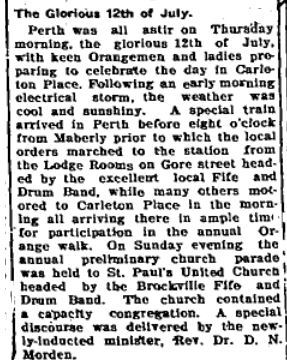

An Orange parade was often led by one of the members on a white horse, symbolizing the white horse ridden by King William of Orange, at the Battle of the Boyne.
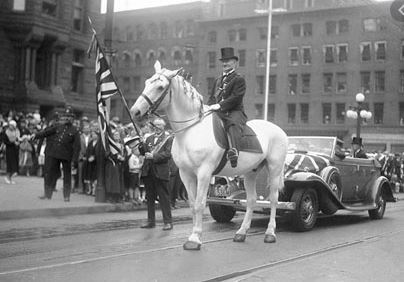
Some of the symbols worn by members of the Orange Order
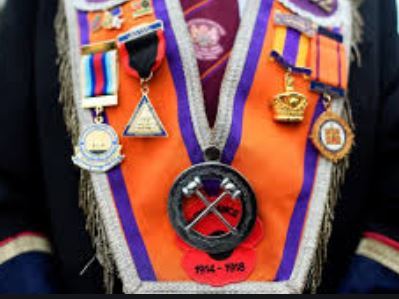
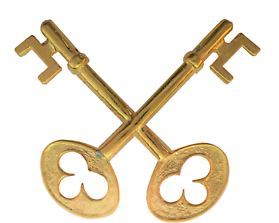
To assist in the war efforts, every Orange Lodge in Canada was turned into a recruiting office in WWII
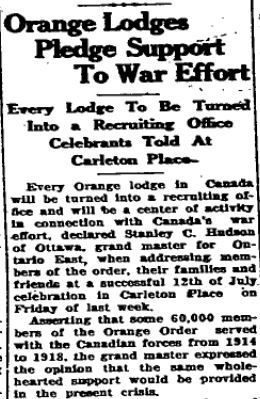
Lanark County Oranges Lodges, Active in 1946
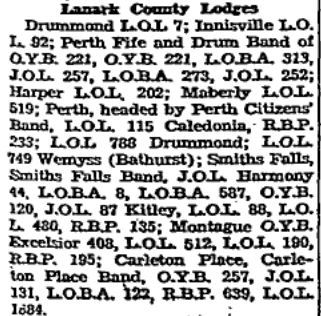
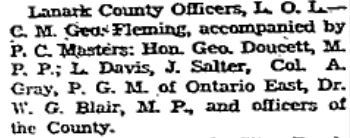
In 1957, the Orange Day celebrations were held in Almonte, and Rev. Canon J.W.R. Meaken, shared some comments as part of his address to begin the meeting:
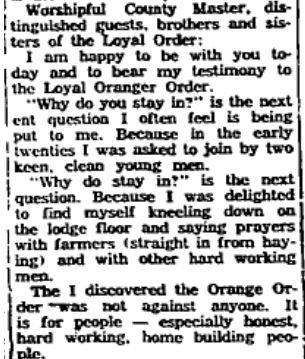
Interest in joining the Orange Order began to dwindle in the 1960s and 1970s, and instead of thousands attending the annual parade, it became ‘hundreds’.
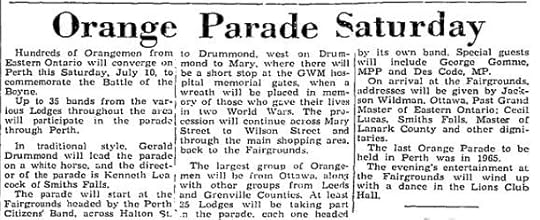
Memberships grew smaller and smaller in many parts of the country, and in Lanark County, one of the oldest Orange Lodges, in Carleton Place, closed after 185 years, in January of 2015. The existing membership would merge with the Montague lodge # 512. (The Grand Lodge of Ireland issued the original warrant for the Carleton Place Lodge back in 1830.)
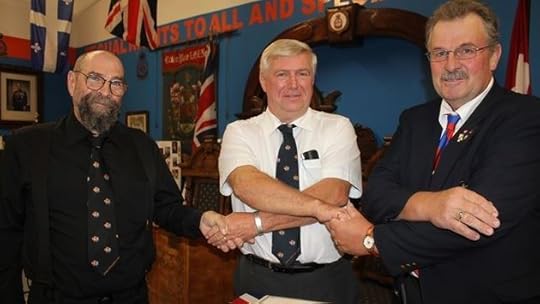
At one time, there were 30 Lodges throughout Lanark County. After the closing of the Carleton Place Lodge in 2015, only the Montague Lodge and the Smiths Falls Lodge (No. 88), remained. The Almonte Lodge (No. 378) amalgamated with Carleton Place in 1987, Franktown in Beckwith Township (No. 381) in 1992, and Drummond Centre in Drummond/North Elmsley Township (No. 7) in 2013.
…………
Throughout the many decades of the celebration of Orangemen, their sometimes vocal, and occasionally violent encounters with the Catholics, our family will continue to celebrate July 12th for a different reason. July 12th, for us, was the joining of the two religions, historically separated on this date, a young Protestant girl from the west, and a handsome Roman Catholic lad from Drummond Township.
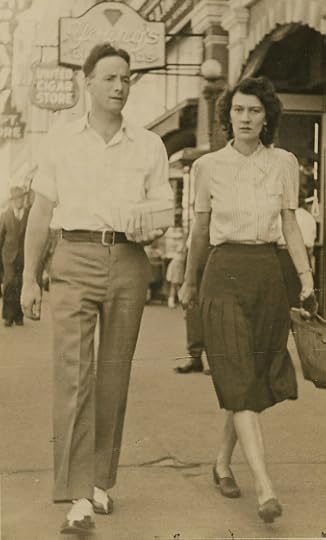
Maybe they were ahead of their time. It was 1943 afterall, and marrying outside of one’s religion was often frowned upon. Luckily for us, the five children that followed in this unconventional marriage, would grow up in a home where we learned to respect different opinions, different points of view, and different religions.
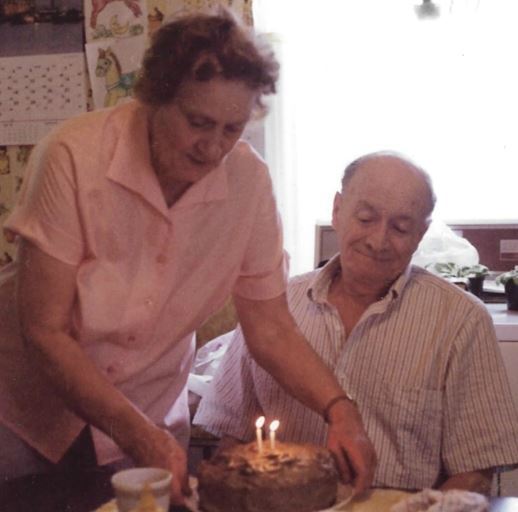
And so, the Protestant girl, and the Catholic boy were married for almost 50 years, until Dad passed away.
I still smile when I hear that Irish Rover’s tune, “The Orange and the Green”, and July 12th, for us, will always be a special day in our own family history.
………….
July 4, 2021
Silver Lake Sundays
It always seemed as though Highway 7 was busy, cars and trucks rushing along, especially on the weekends, and even more so during the summer months. According to Dad, it wasn’t just the local people travelling between Perth and Sharbot Lake, but all the tourists that rambled along the Trans-Canada Highway, doing a little sight-seeing, and exploring the countryside. Whatever the reason, Highway 7 was busy as usual that Sunday afternoon so long ago, as we made our way to Silver Lake.
Although it was just a twenty minute drive from the old house, the ride seemed to take forever, our legs sticking to the hot vinyl seats in the back of the Buick, long before the days of air conditioning. It wasn’t until I saw the signs for the village of Maberly that I breathed a sigh of relief, knowing we’d be there in just a few more minutes. Dad flicked on his signal, I felt the car slow down, and we turned, and drove up the hill to the entry booth at Silver Lake Provincial Park. The park worker came over to the window, Dad showed his seasons pass, and he waved us through.

Dad found a spot close to the picnic area, and we drove in and parked the car. That was the easy part. The tricky part was finding just the right picnic table. Dad liked a table to be in the shade. Mother preferred a place with a little sun. Dad said he needed to be out of the wind so he could light his little green Coleman stove. Mother liked a breeze to keep the bugs away. So the hunt for the best table usually took a little longer, sometimes a lot longer, than it should have. After all, we just wanted to cool off in the water, and that beautiful lake stretching out ahead of us, sparkling in the sun, was all we could think about. Who cared where we ate supper?
The hunt for the perfect table continued. Should we use one of the tables under the shelter in case it rained, or maybe one of the ones farther up the hill, off by itself? There was a good table close to the main beach, but there were a bunch of rowdy people sitting at the table right next to it, and Mother wondered aloud if that’s why no one else was using it.
They finally spotted a table halfway up the hill, toward the lower beach, and sent one of us up the ridge to ‘save’ it. Dad opened the trunk, and we each grabbed something, and made our way up to the table. The table cloth, Coleman stove, cooler, plastic cups and plates, paper napkins, transistor radio, saucepans, and cooking utensils, were all brought to the site. We hauled the picnic gear up the slope, and set it all down on the seats, while Mother spread out the red plastic table cloth. It wasn’t until we placed the big cooler on the table that we noticed that the table rocked back and forth. Good grief! I hoped to myself that we wouldn’t have to pick another table! Dad got the boys to lift one end, while he lifted the other, and re-positioned it until it was stable. What a relief!
While Mother took everything out of the cooler, Dad turned on his portable radio, extended the antenna, and went about setting up his little green metal stove.

I grabbed a towel from the top of the cooler, and headed down to the beach, finally free to jump in the lake and get cooled off. As I got closer to the beach, the noise and laughter from all of the kids grew louder, and I could see people jumping off of rubber rafts, and throwing beach balls around, and some little kids were filling up sand pails, and making sand castles along the shore.
I stepped cautiously into the shallow water along the sandy shore and it felt cool. Because I was right in the center of the main beach, I got splashed again and again by the other kids running in and out and jumping nearby. I walked out slowly, up to my knees, and then finally plunged in all the way, and the water didn’t seem cool anymore; it was just perfect. There was a kid close by with a diving mask on, and another kid with a fancy inflatable raft, and he was gliding along the surface using his hands to propel himself. I wondered what it would be like to have these expensive gadgets to play with in the water. We had an old beach ball that kept shrinking because it leaked air, and that was about it. Oh well, it was fun to splash around and cool off just the same.
I put my face in the water and opened my eyes. The bottom was sandy, with some smooth pebbles, and a couple of snail shells. There were some tiny minnows darting around, and lots of arms and legs of kids playing nearby. I pulled my face back out of the water, took a deep breath, and propelled myself down to the bottom, pushing the water back with my arms, moving farther from the beach. When I felt myself running out of air I resurfaced, rubbed my eyes, and looked back at the beach. There were lots of parents relaxing in lawn chairs, watching their kids swim. Little kids were playing close to the shore, and bigger kids were splashing around, squealing, laughing, and the bright July sun gleamed and glistened on the surface of the water.
I played in the water for hours, bobbing at the surface, swimming along the bottom, jumping into the gentle waves, and floating on my back and kicking my feet, then gliding backwards, staring up at the bright sun and the blue sky. I watched as new kids came into the water, and other kids left the beach, heading over to the playground, past the parking lot. By the time Mother came down to the beach to call me for supper I’d had plenty of time to swim, my fingertips were wrinkly, and I was ready to come out of the water.
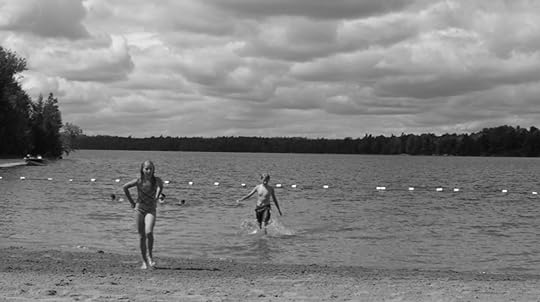
As we walked up the path to the picnic table I began to smell the gas from the Coleman stove, and the savoury scent of the hot dogs, and I began to realize how hungry I was. The fresh corn was already boiled and stacked on a tray. There was a bowl of baked beans, a homemade potato salad, some deviled eggs, homemade rolls, pickles, and a jellied salad. Everything tasted good, partly because I was hungry from swimming, but mostly because we were outside. Things always seemed to taste better outdoors in the fresh air for some reason. Dessert was Mother’s lemon squares. There was also a cookie tin of brownies, and some butter tarts. No one went hungry at our picnics; that was for sure.
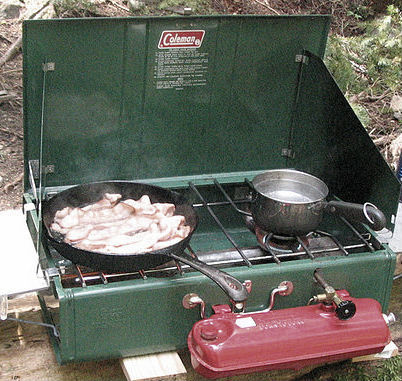
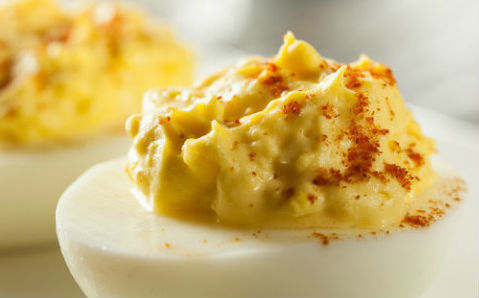

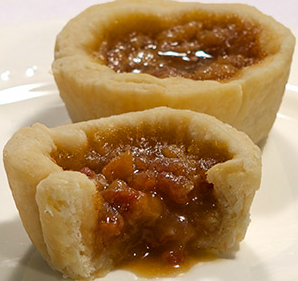
After we’d finished and cleaned up, we decided to walk across the road to Barbary’s store. The traffic was very busy on Highway 7, so we had to wait quite a while until both lanes were clear, and then walked quickly across. The store was huge, and they had everything – groceries, camping gear, water toys, even life jackets; anything that you might need if you were camping, or visiting the lake. They had lots of souvenirs, postcards, and knick-knacks for tourists. Dad asked me if I’d like a chocolate bar, but I’d spotted something even better. The store carried Partridge Family bubblegum cards, and I was collecting them, so I asked if I could have those instead. Dad agreed and bought me those, and bought chocolate bars for everyone else, and he also picked up a fly swatter that he’d spotted hanging up by the cash register.
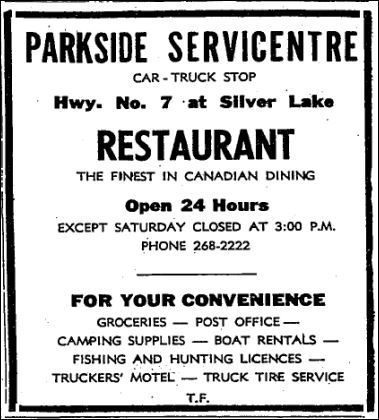

We left the store, and once again waited a while until the road was clear, and walked quickly across. We strolled up the hill to the park entrance, through the gates, past the washrooms and change rooms, down the hill through the parking lot, and back up to the picnic table. We each picked up something, and headed down the hill to the car, and packed everything back into the trunk.
Once the car was packed, we went for a walk along the smaller, quieter beach on the other side of the picnic area. It was more peaceful at that beach, and there were only one or two kids with their parents down near the water. As we walked along I picked up some smooth stones, and a couple of snail shells, to bring back home. The early evening sun was lower in the sky, but still bright, and it bounced and played off of the water, and shimmered through the trees along the shore. The air was fresh and clean, and carried with it the soft scents of the lake and the nearby trees.
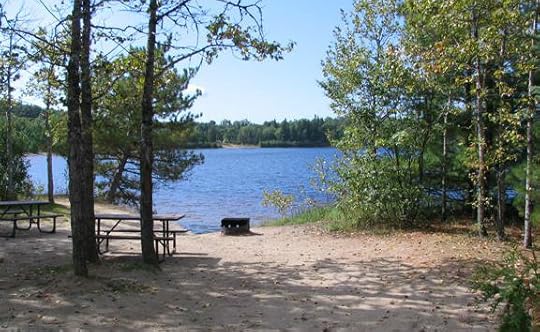
Many Sunday afternoons were spent at Silver Lake. There were no splash pads, or giant water slides. We swam without water wings. Our only concern was how fast we could get into the lake to swim, and not how we looked in our bathing suits. The old car had no air conditioning, and our entertainment at supper consisted of a small transistor radio. If we wanted to call a friend we had to wait ‘til we got home and hope that none of the neighbours was using the party line. We filled our dinner plates time and again, stuffed ourselves with desserts, and never counted a single calorie. We didn’t send text messages; instead we talked to each other, and shared a few laughs.
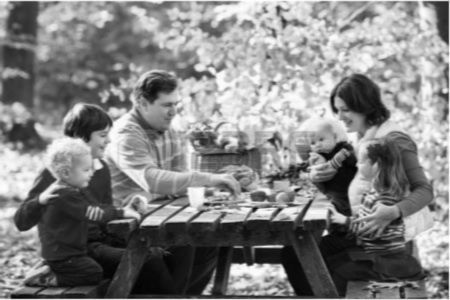
Although there have been many useful advances in technology since those days, I will always treasure our simple summer picnics. I yearn for the clear water, the beach-scented air, and quiet walks along the sandy shores. I miss the shrieks of genuine laughter, and carefree splashing in the warm waves. I dream of the distinctive smell of the Coleman stove, and the unmistakable flavours of the homemade comfort foods. Most of all, I long for the effortless, unguarded conversations that we shared between bites. Surely in today’s hectic, stressful world, constantly connected to the internet, we could all find some welcome relief in the peace, tranquility and simplicity of an old fashioned picnic at the lake.
June 22, 2021
June at the Stafford House and the First Cutting of the Hay

By June each year, the hay was tall enough for the first cut of the season. When early summer is upon us, I’m reminded of the sweet, green scents of the fresh cut hay lying in the fields.

By this time in June, the delicate pale shades of spring had come into their full summer greens.
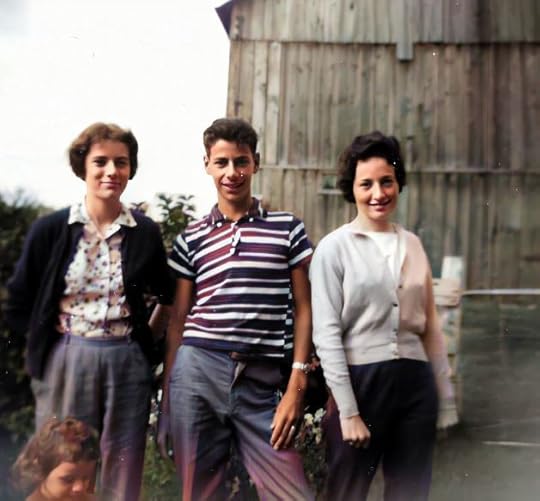
The heat bugs, crickets, and bullfrogs sang their songs back in the lowlands, behind the old house.

The hot sun warmed our bones, and the long, hazy days were rich with humidity.
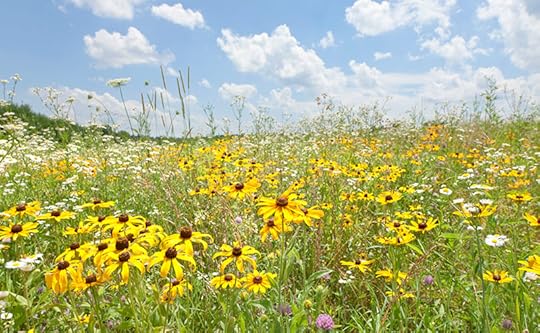
Days were always busy this time of year, and local farmers hauled their wagons, and chugged up and down the Third Line, like a great hay parade passing by.
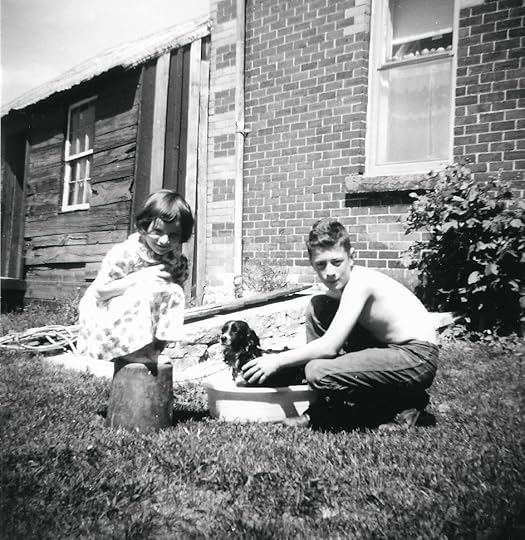
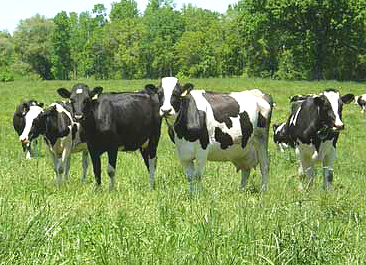
We were often tempted to stop by the local general store for an icy cold bottle of pop, or maybe buy a popsicle and split it with a friend. Owners, Jim and Helen Cavanagh were always there to greet us with a kind smile, and have a chat about the local news around DeWitt’s Corners.
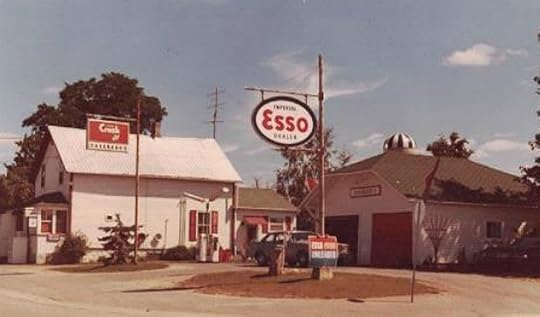
Sometimes it was so hot by late June that even Shep, Cavanagh’s dog, would curl up beside the millstone outside the store, and take a break from the heat.
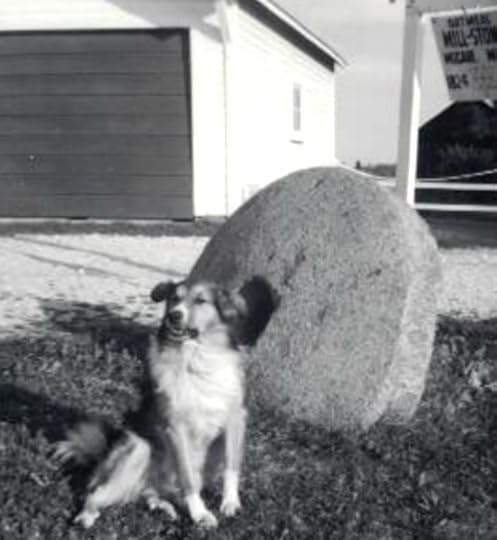
The unmistakable fragrance of the newly-cut-hay was all around us. For anyone who has ever lived in farm country, it’s a fresh, green scent that could be bottled-up as perfume, and called ‘Summer’.
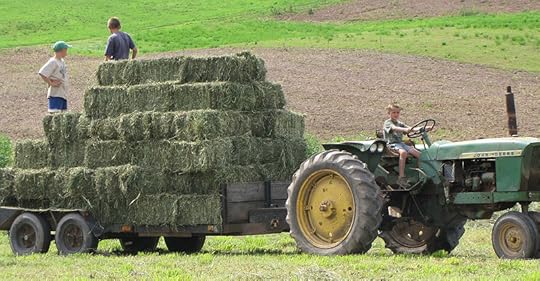
It was always nice at the end of a long, hot day to cool off in the Tay River, at Carl Adams’ swimming hole.
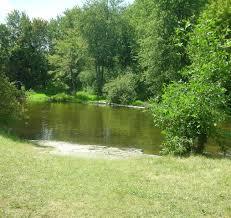

Just a quick ride on our bikes, and we’d be there in no time at all, jumping in, splashing each other, laughing, cooling off after a long, hot day in the Lanark County sunshine.
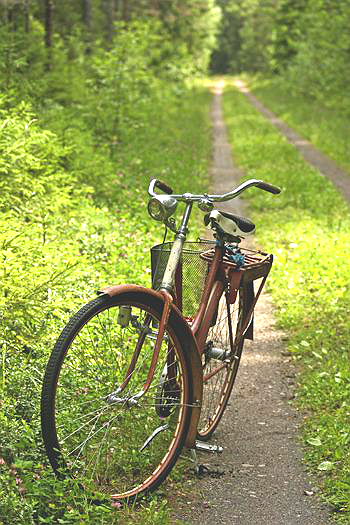
Or sometimes, we’d ride our bikes up the Third Line and jump off of Jordan’s bridge, into the cool waters of Christie Lake.

Now that summer is officially here, it’s nice to remember the sights, smells and sounds of the farm country, and how the longest days of the year seemed to go on forever……………

………………………………………………………………………………………………………………..
Photo: Korry’s farm – farmed by Andrew, Ethel Korry and later by their son George and his wife Merle.Photo: Cavanagh’s store and their dog Shep – JoAnne Cavanagh ButlerPhoto: Stafford girls in front of the barn, with their cousin Ronald Charles ‘Ron’ Waterhouse (1937-2015). Ron was the son of Mildred ‘Mill’ (Rutherford) Waterhouse, Audry (Rutherford) Stafford’s eldest sister. Ron was visiting from Edmonton, Alberta.Great Aunt Clara’s Late June Roses

Although it didn’t look like much until late in June each year, around the third or fourth week of the month, the old rosebush, planted by Dad’s Aunt Clara Richards Carberry, sprang reliably back to life. Great Aunt Clara had planted the rosebush back in the 1940s, along our fence, on the east side of the house, under the poplar trees.
It was an uncertain time when she planted that rosebush, the years between 1939 and 1945, when World War II raged on, separating families from loved ones, and prematurely ending young lives, as they fought bravely, on the front lines in Europe.

By the time that I was old enough to be aware of the rosebush, it had spread, as perennials will, and imparted a bright pink show of fragrant roses that stretched for several yards, along the old fence. For the entire five decades that we lived in the house, that rosebush bloomed faithfully. Without any pruning or watering, it gave us a lovely fuchsia display, each year, shortly after the summer solstice had passed, as though that was its signal to begin to bloom.
Maybe in such an unsettled time in our history, Clara wanted to create some beauty that would last; something predictable and steadfast; something she could count on.
So the rosebush bloomed like clockwork, late in June, each year for decades, watching silently from its sheltered patch under the poplars, along the fence, as one by one we finished our years in school, and left the old homestead, to go out and make our way in the world. It watched all five of us come and go, and it thrived long past that time, for another quarter of a century, until our father passed away, and our Mother sold the house, and moved to town.
With a legacy like that, how could any of the short-lived ‘annual’ plants ever compare to this faithful old perennial, planted by Clara, so many years ago? More importantly, how could we ever forget those bright, pink, fragrant roses, and how they graced the edge of our yard, so beautifully each year, late in June?
……
“Great Aunt Clara’s Late June Roses”, an excerpt from: “Lanark County Calendar – Four Seasons on the Third Line”, ISBN 9780987 702630

June 20, 2021
Dad: A Father’s Day Tribute
 Tobias ‘Tib’ ‘Tim’ Stafford – 1918-1992
Tobias ‘Tib’ ‘Tim’ Stafford – 1918-1992In the quietest moments, without trying to teach, life’s lessons unfolded and we were imprinted forever with a strong work ethic, the power of a kind word, and the value of integrity….
Who was he? What was he like? These are the questions that might be asked by curious grandchildren, and great-grandchildren, and their children in the years to come. His descendants will walk this earth, long after our time has passed, when those who knew him in this life are themselves just a memory, a grainy photo in someone’s dusty old album, or a name that’s mentioned from time to time when family members gather together.
His ancestors came to Canada in 1816 and settled in Drummond Township, not far from Ferguson Falls. Both sides were from southern Ireland, and both Roman Catholics, weary of the treatment of their kind by the British, and longing for freedom and the opportunity to thrive and prosper.
Dad was the youngest son, of a youngest son, of a youngest son of the pioneer settler, he was named for.
He attended school in Prestonvale, and played ball on the local team, and the Innisville team were their greatest rivals.
Church attendance was non-negotiable and held at St. Patrick’s each Sunday without fail.
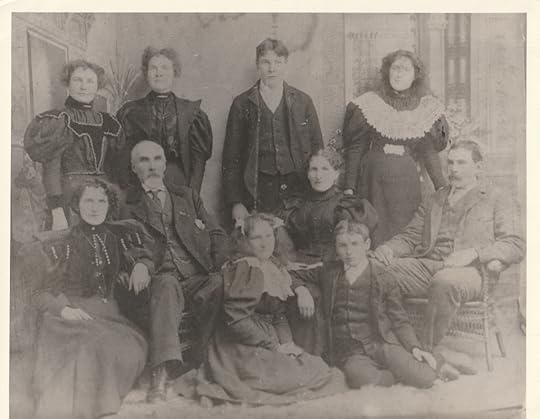
photo: 1896, family of Thomas Stafford & Mary Carroll Stafford (seated in the middle) Thomas was the youngest son of pioneer settler Tobias Stafford and Elizabeth McGarry, 11th concession, Lot 10, Drummond Township. Seated in the front is Dad’s father, Michael Vincent ‘Vince’ Stafford.
(back row: Anne, Mary, Thomas Julia, middle row: Margaret beside her father, and Peter beside his mother, Anastasia seated beside Vince in the front row)
1932 Prestonvale Ball Team
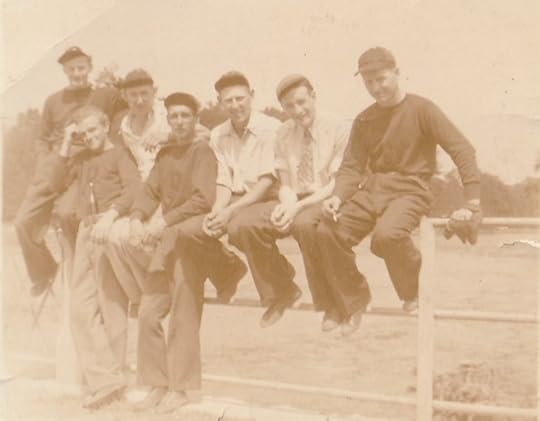
The Prestonvale ball team in 1932, Tobias ‘Tib’ Stafford seated 2nd from the end, wearing a tie.
(other players unknown, but may be some of the same players as the 1934 team below)

Prestonvale Baseball Team 1934
Back row: Bob McEwen, Mansell Horricks, Henry McFarlane, Tobias ‘Tib’ Stafford, Roy McEwen, Dawson Horricks
Front row: Ossie Rothwell, Billy Tullis, Lloyd Horricks, John Dickenson
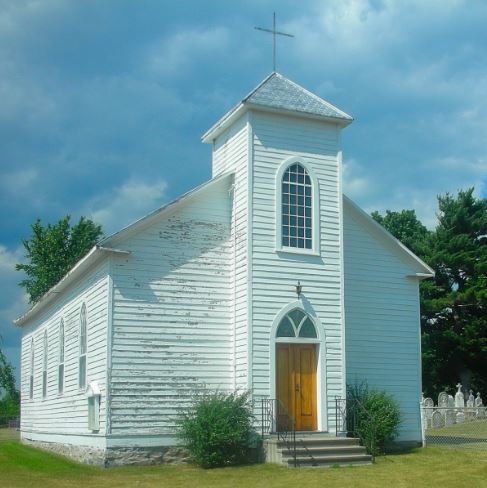
St. Patrick’s Church, Ferguson Falls, Ontario – where Dad and his family attended services
He enlisted in WWII, in the R.C.A.F., where he met our mother, while they were both stationed at the No. 8 Bombing and Gunnery School in Lethbridge, Alberta. They married in 1943, and he was posted overseas in Bournemouth, England.
Stafford House

1946 – Dad was discharged from the Royal Canadian Air Force, and he, Mother, and their two babies, Tim and Judy, moved to the home they would occupy for the next 50 years – the Stafford House.

By the 1960s, the family had grown! Left to right – Roger Stafford, Arlene on Judy’s lap, Mother – Audry (Rutherford) Stafford, Dad – Tobias ‘Tib’, ‘Tim’ Stafford, Tim Stafford, and Jackie Stafford.
Dad farmed the land for some years, then the cattle became ill with tuberculosis and had to be destroyed. He hauled milk to local cheese factories, spent some years working on the railroad, a couple of decades delivering milk for Chaplain’s Dairy in Glen Tay, then finished his workdays at Wampole Pharmaceutical on Hwy 7, in 1983, when he retired.
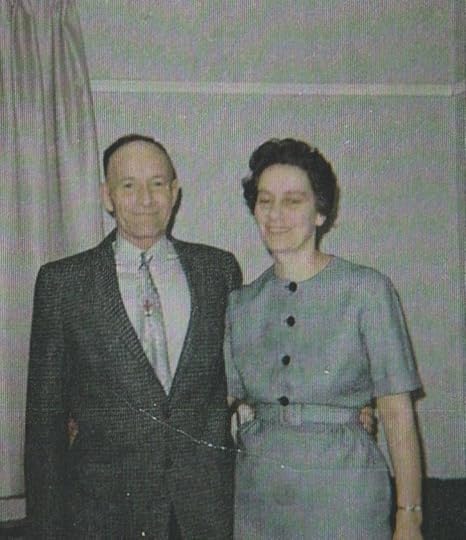
1968 – their 25th wedding anniversary
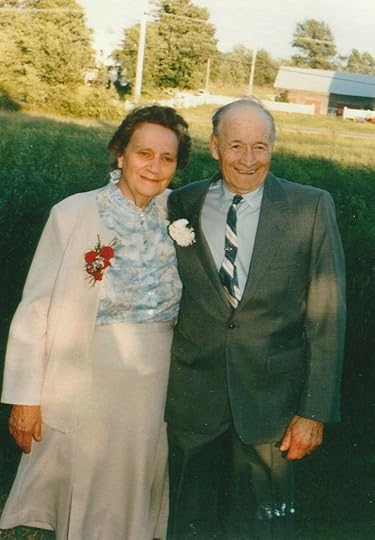
1988 – 45th Wedding Anniversary – with Korry’s farm in the background
What was he like?
Dad was soft-spoken, and for the most part was even-tempered and easy to get along with. His family was very important to him and he enjoyed spending time together at Christmas, birthdays, and other special occasions. He kept his cars in immaculate condition and loved to take us all for Sunday drives into the country. He enjoyed nature and called us over to see a hummingbird flutter, or a sun-dog in the sky. He loved to hear the birds calling, high up in the maple trees, and didn’t mind the bats swooping around on hot summer evenings. He took great pride in the appearance of his lawn and enjoyed cutting it and trimming the long grass.
 Ready for a Sunday Drive – L to R: Roger, Jackie, Tim, Dad, Arlene
Ready for a Sunday Drive – L to R: Roger, Jackie, Tim, Dad, ArleneHow do I remember him on Father’s Day?
He was the slayer of dragons who hid in the dark corners of my room at night. He was the one I ran to during thunderstorms, who distracted me from my fears by showing me his watch with the hands that glowed in the dark. He was a night-time story-teller and a bed-time book-reader. He was the tour-guide on Sunday drives, and the local historian on trips to the cemetery. He believed that everyone deserved a treat – every day, and he brought home chocolate bars, tucked into his lunch pail, for each one of us, every evening. He was a great believer in common sense and had a surprisingly simple solution for almost every problem. He showed us how a man treats a woman he loves as he joked around and also complimented our mother as though they were still dating. He got up each day, dressed neatly, and went off to work, and I never heard him complain about his job, although I’m sure there were times that he could have.
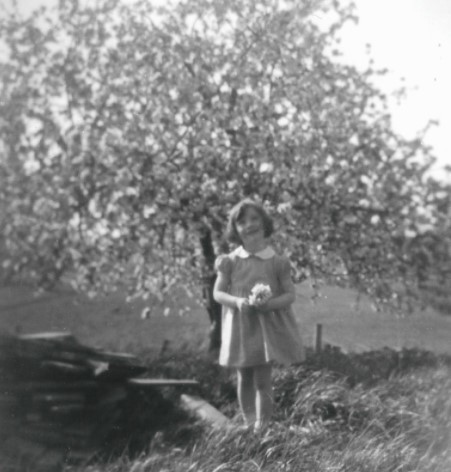
And so as we pause today to thank the fathers of the world, some who are still here, and as we also remember those who are no longer with us, I will finish with a quote that reminds me of this quiet, thoughtful man who we called, “Dad”:
“He didn’t tell me how to live,
He lived, and let me watch him do it”
Clarence Buddington Kelland
May 20, 2021
Rideau Ferry Inn – Those Hot Summer Nights!
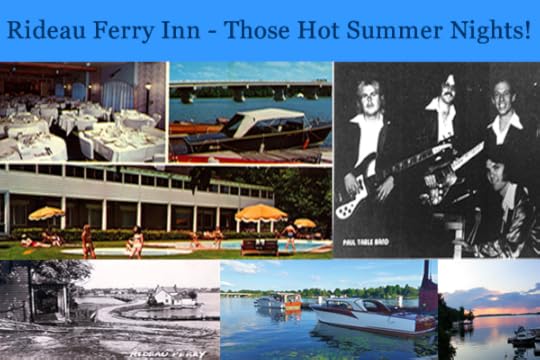
Oh, those hot summer nights at the Rideau Ferry Inn! The dancing, the laughter, stolen kisses, sneaking drinks in the parking lot, and the best live rock and roll around!
Its official name back then, was the Poonamalie Pavilion, but nobody called it that. To my friends and me, it was simply the Rideau Ferry Inn; and you could find us there most weekend nights in the summer, socializing, laughing, and dancing the night away.
Situated along the clear, blue waters of the Rideau, the Rideau Ferry Inn has hosted many generations of tourists and boaters, providing sumptuous meals, comfortable accommodation, and lively entertainment. Arguably, the highlight of the small settlement of Rideau Ferry, our former teenage haunt, wasn’t the original structure at this location. The original building was actually a home.
The original structure was a house built in 1853 by Archibald Campbell. Archibald married Elizabeth Buchanan, a preacher’s daughter. Her father was the Reverend George Buchanan, and was one of the early Presbyterian ministers of Beckwith Township, serving the congregation at Franktown.
Their daughter, Helen Buchanan Campbell, married John Coutts. As her parents were aging, and needed assistance, the couple moved in with them in 1870. During that time, John made some additions to the home, and when he was finished, they not only had ample room for themselves, but had more than enough room to accommodate guests. They began to rent rooms in the house to summer tourists, who were traveling by boat ,along the mighty Rideau waterways.

As the years went by, their home became known as ‘Coutts House’, and eventually, had the reputation of being a very fine hotel. In 1893 a three-storey addition was built at the back of the house. A large dining room was added to the first floor. The second and third floors had fifteen hotel rooms each, and an indoor bathroom.
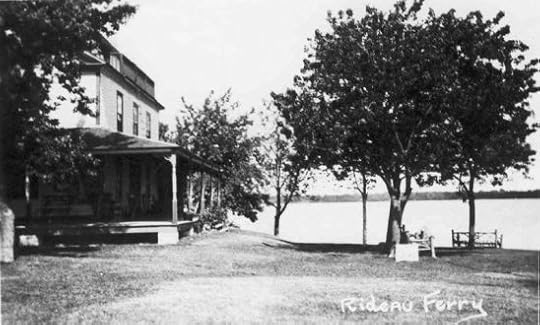
After 1905, the building was rented to a series of business men. During the 1920s and 30s, regattas became popular, and Coutts House held canoe races, and rowboats races. The Coutts family also sponsored competitions for sailboats, and it was the site of many grand daytime celebrations, and intimate evening affairs, for the wealthy travelers, visiting in the summer.
In 1947, Doug Wallace, native of Osgoode bought Coutts House, tore it down, and built a new structure with wood framing, and grey granite blocks. It was a two-storey building, and the second floor featured a large dance area, with seating on three sides.
By the 1960s, the building had become known as the Rideau Ferry Inn, and during this time, became licensed for liquor sales. Up until that time people would smuggle in their own booze, particularly in the roaring twenties when rum-running along the Rideau had its hey-day.

It was in the 1970s, that I first heard the tales about the popular night spot, and all the good times that were had at the Rideau Ferry Inn. There were stories told up and down the halls of the Perth High School – stories of summer romances with cottagers staying at seasonal properties nearby, or the ultra-cool teens that traveled by boat along the Rideau, with their parents. There was also talk of the teenage kids from the States, and their hip clothing and accessories; styles that would take years to reach our little communities near Perth. There were lots of accounts at our high school of the talented rock bands that performed, and of the nights spent dancing to the top hits played by edgy disc jockeys. I couldn’t wait to go and see it for myself.
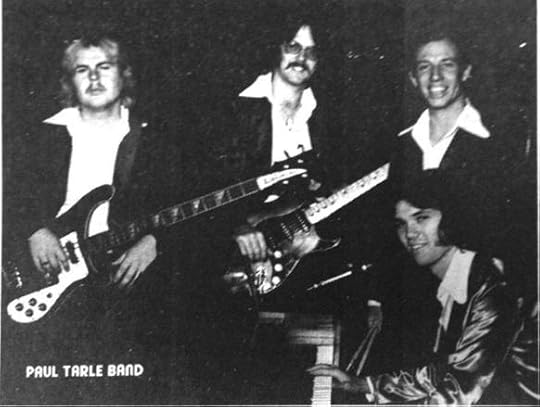
The main house-band at ‘The Inn’ in the early 1970s was the Paul Tarle Band – and we showed off our cool dance moves, as we listened to their popular rock classics.

One of the best parties of our steamy Lanark County summers was the annual Rideau Ferry Regatta. Beautiful, sleek, boats from all over, competing for the sought-after prizes, and the prestige of being ‘Number 1’ on the big lakes.
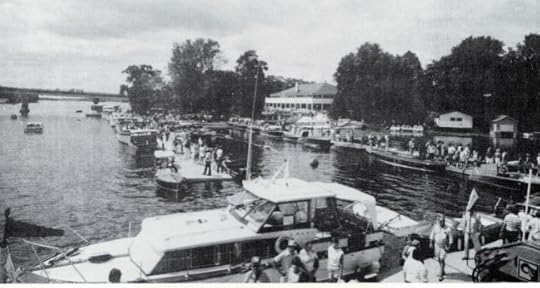
Regattas were all about hot sun, cold beers, the cool, clear waters of the Rideau Lakes, and beautiful boats all around us.

We’ll never forget the annual regattas, or the great music at the Rideau Ferry Inn. Bands like ‘Sammy Seaman’ and his group kept us up until the wee hours. Some nights it was ‘Woody Herman and the Young Thundering Herd’, and other evenings we were entertained by the ‘Paul Chabot Band’. Occasionally, instead of live bands at the ‘Inn’, there was a ‘Disco’ dance provided by a local disc jockey, by the name of ‘Sounds Great’.
Many years after our frequent teenage visits to the Rideau Ferry Inn, the building was purchased by Elmer and Eva Purdon. It was still ‘the’ place at that time to host fancy wedding receptions, or 50th wedding anniversary celebrations.
Because we’d had so many good times at the Rideau Ferry Inn, it was a terrible shock for my friends and I when we heard about the fire in February of 1986, that destroyed our former dance hall. The fire started on the top floor, where the dances had been held for so many years. The ground floor was also destroyed in the fire, and that is where the kitchen, the large dining room, and bar were located.
My friends and I drove down to Rideau Ferry a few days after the fire. I don’t think it was so much out of curiosity, but more out of disbelief. Could it be true, that the place where we’d passed so many of our happy youthful hours was really gone? There were so many memories of friendships, dancing, and all of the special evenings we spent at the Rideau Ferry Inn.
We drove up to where the Inn had stood, and looked around. No one said a word. I think that as we stared at the charred foundation of the building, each of us was recalling our own versions of the times spent there, in our youth. They were such innocent, awkward, magical, teenage times. We sat there for a few more moments, still silent, and then drove away, back up the Ferry Road toward Perth.
…
The building may be gone, but our fond memories of the Rideau Ferry Inn will remain with us forever. We will always remember the music, the friends, and the good times. Those long summer nights, when the stars seemed to shine a little brighter, the sunsets glowed a little softer. The peaceful, pristine, waters of the Rideau Lakes made a perfect backdrop for those innocent days of our youth, when life stretched out ahead of us…..so full of promise, and our dreams for the future.
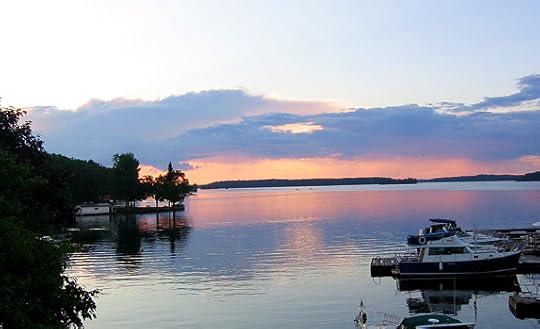
………………..
An excerpt from – ‘Revelry and Rogues on the Rideau’ – ‘Lanark County Chronicle’ available in local book stores, or online. ISBN 978-0-9877026-23

……..
Local Names:
Although there were lots of tourists and visitors in the summer, they were only there for a few short weeks at most. We became acquainted with many of the folks who lived year-round at Rideau Ferry, and some of the local names at that time were: McLean, Donaldson, Buchanan, Gemmill, Frost, Sewell, Coutts, Gallagher, Beveridge, McKay, Wills, McVeety, Millar, Tully, Oliver, Dettrick, Bethune, Purdon, Hitchcock, Fitzgerald, Hall, Gould, Irving, Joynt, King, McCue, Wallace, McKay and Campbell.
…………
Join the author on a steamy hot summer night, park your car outside the Rideau Ferry Inn in the ‘passion pit’, duck as the beer-bottles fly, and the action heats up outside. Hear some of the top bands from the 1960s, 1970s, and 1980s play some classic rock and roll along the peaceful shores of the Rideau – read about it in the new book, released September 2020:
“Lanark County Collection: Winding Our Way Down Memory Lane”

available at The Book Nook, and The Bookworm, in Perth, and Mill Street Books in Almonte.
Also online at http://www.staffordwilson.com
photos: Perth Historical Society, Carol-Ann McDougall, Perth Remembered, Vintage Smiths Falls and Perth, The Perth Courier, Georgia McNally, Vintage Race Boat Shop, and from private collections.For boating on the big lakes – Rideau Ferry Marina
……….
May 11, 2021
‘Witching’ or ‘Dowsing’ for Water
[image error]
I often wonder what went through our Mother’s mind, when Dad informed her that there was no indoor plumbing in the farmhouse, on the Third Line of Bathurst, where they would be living, after the war.
They purchased the farm from Dad’s aunt and uncle, partly with the help of a Veteran’s Grant, in 1946, when Dad returned from overseas.
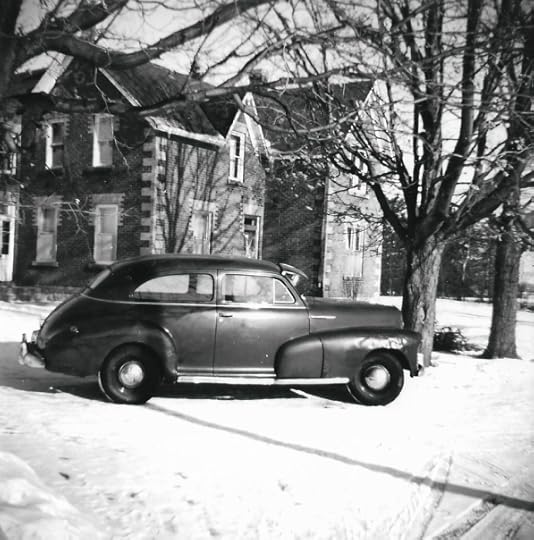
With two babies in diapers, I can’t imagine that my Mother was very happy at the prospect of drawing water from a well, with a hand-pump, a hundred yards from the house. There was a big cement cistern in the basement as well, which collected rain water, but that was just for washing, not drinking.
Water was often in short supply, and almost every year by summer’s end, the well was running dry. When Dad worked for Chaplin’s Dairy, in Glen Tay, he brought water home from the dairy at night, in big metal milk cans, to hold us over, for a while.
Drilling a well was an expensive project to undertake. People paid by the foot, and we’d all heard the horror stories about a neighbour or acquaintance, who had paid for drilling but had not ‘hit’ water in the process.
The practice in those days, back in the 1950s and 1960s, was to hire a ‘Switcher’, or ‘Diviner’, who would walk the property, and use a method called ‘Dowsing’. In fact, this was such a common practice at the time that I recall this technique being called by a few different names: Witching, Switching, and Divining, depending on who you were talking to.
[image error]
Edgar Hamm calls it ‘Witching’, but some call it ‘DowsingIn many cases, a drilling company either had someone on staff, or knew a person with this skill, and brought them along to assist in finding the best spot to drill, where the water was closest to the surface.
[image error]
The Thompson brothers, Jerry and Connie drilled our well, and they hired Jack Dowdall from Glen Tay, to walk the land with the apple branch to detect the water.
“I remember when a new well was drilled, and when the men came with the dowsing stick. I can’t recall when they called it – I think a divining stick or rod, but it was used to find water.
I was there, and asked if I could try it. The men seemed amused, but he told me what to do. I can’t remember if I felt anything or not, but when he found the water, it seemed to pull him and the stick almost down to the ground.”
Jackie Stafford WhartonI recall in those days they used a willow branch, or apple branch, and fashioned it so that it had two short ends, and one long end. Willow or apple was used to create the strongest ‘pull’ to the water. I’ve also heard that peach branches, or hazel branches conduct water in the same way.
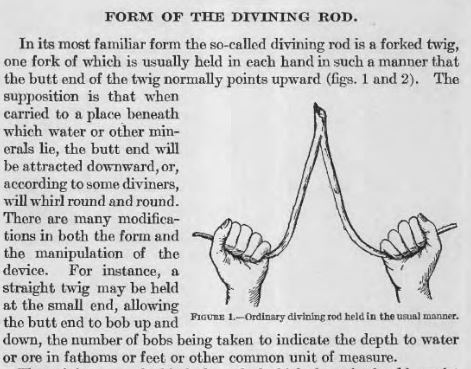
The practice of dowsing, goes back to the 15th century in Europe, where it was used not only to find water, but to detect metals as well.
[image error]
Divining Rod, 18th century BritainDowsing or Witching was used extensively during the building of the railroad across Canada, to find drinking water for the crew, along the route.
[image error]
Water-witching, 1907Farmers have used water-witching for generations, to determine the best place to dig their wells, and to find a source of drinking water for their cattle in a pasture.
[image error]
George Casely uses a hazel branch to find water on his farm, 1942The practice continues to be used today, in some cities in Canada. Metal rods are used instead of the old-fashioned tree branches.
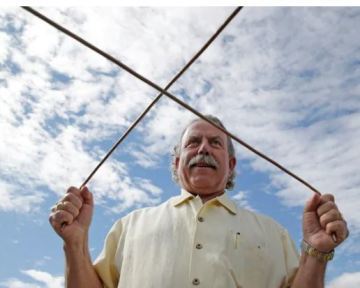
“The city (Ottawa) says it still routinely uses the age-old detection technique, also known as dowsing or water witching.
“Definitely the other technology works more consistently,” said Quentin Levesque, manager of what’s known as the city’s “locates group.”
“Should they have difficulties or troubles using the other equipment, the divining rod is there as well.”
The practice involves walking slowly over an area while holding one of the L-shaped rods in each hand. When the two rods cross, that’s supposed to signify the diviner is standing over water.”
Some Call it ‘A Gift’Can anyone use divining rods, or a willow switch to find water?
Some say it is a gift, and only those with this natural, intuitive, sensing ability can detect water. Some say that it doesn’t necessarily pass from father to son, or down through the family.
Some people claim that dowsing is a psychic ability, and some scoff and say that it is a learned ability, and that anyone can be trained to do it.
Whether it’s a gift, or something that can be learned, it’s still being practiced today by some, to pinpoint sources of water.
Were my parents happy when the well-witcher located the water in our yard, and the Thompson brothers drilled our well? They sure were!
Was it mystical or magical or other-worldly, when our Mother turned on the tap in the old house, and drinking water gushed out for the first time?
I’m sure to her, it was.
[image error]
Audry (Rutherford) Stafford, in front of the old house, c. 1965Jerry Thompson’s siblings: Vera (Percy Wills), Gordenia (Winfred Truelove), Marie (Maurice Wills), Gwen (Frank Turnbull), Connell ‘Connie’ (Phyllis North) Thompson, and Murray (Roberta Livingstone)Thompson.
Jack Dowdall’s siblings: Elizabeth (Clarence Donaldson), Violet (Lawrence Dixon), Lillian (William Kirkham), Laura ( Peter Kirkham), Edna (Joseph Kirkham), Mae (James McLaren), Edward (Mildred Foshay), Garnet (Margaret Stewart), William (Eleanor Gordon), George (Pearl Gordon), and Frank (Carmel Kirkham).
Meet Jerry, Connie and Jack, as they find the best spot to dig a country well, in the story: “Mysterious Ways of the Water Witcher”, in the book – Lanark County Collection ISBN 978-0987-7026-78
(available at The Book Nook in Perth https://thebooknookperth.com/The Bookworm in Perth, https://www.bookwormperth.com/Mill Street Books in Almonte, https://millstreetbooks.com/or online at https://staffordwilson.com/[image error]




